
- Search Search Search …
- Search Search …

Rote Learning Vs Critical Thinking

Learning is defined as the acquisition of knowledge or skills. Knowledge and skills are acquired in various ways:
- Through practice and experience such as riding a bike
- Through study, reading what others have written about the subject
- Through instruction, being taught by someone with the desired knowledge
Teaching techniques have come a long way, and though memorization still has its place in learning, current teaching standards recognize the value of meaningful learning and critical thinking. On the other hand, the concept of standards-based education, while not without some merit, encourages rote learning without much emphasis on critical thinking.
Each style of education impacts students differently and adds to the overall education experience. It’s common to find a variety of teaching techniques and learning skills in each classroom.
What is Rote Learning?
Ah, multiplication tables, state capitols, lists of presidents. Do you recall memorizing these in school? These lists of memorized facts are an example of rote learning.
The basis of rote learning is memorization. Usually, this memorization is acquired through repetition, think chanting your times tables. Memorization is often achieved without any understanding of the reasoning or relationships involved in the learned material.
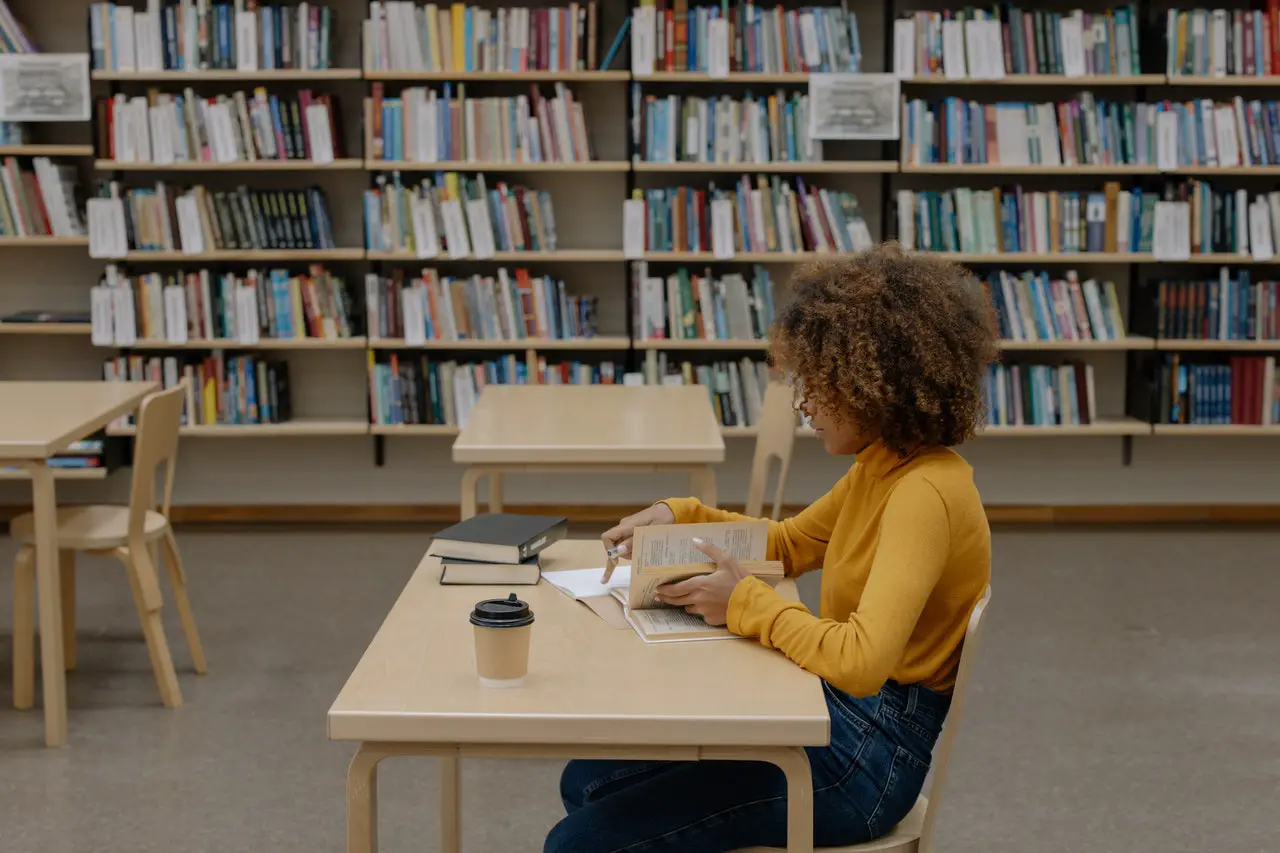
Rote learning can be useful when quick learning is required, such as memorizing a telephone number or address or learning lines for a play. Some students appreciate rote learning techniques when cramming for an exam.
Someone who engages in rote learning may be able to give the impression of understanding without actually having true comprehension of the subject matter. For example, one may be able to pass an exam or quote impressive lists of facts, but may not retain the knowledge or know how to use it to solve a problem.
What is Critical Thinking?
Critical thinking is a process of reasoning in which the person doing the thinking uses factual information gathered from various sources and analyzes that information to come to a logical conclusion, rather than relying on their own reasoning to justify their conclusion.
Critical thinking is often described as being self-directed and self-corrective, meaning under your control and initiative and compensating for your weaknesses and biases. Critical thinking includes problem-solving skills and effective communication skills as well.
Why Use Rote Learning vs Critical Thinking?
There is no faster way to learn a formula or other simple fact than by rote learning. Rote learning frees up your working memory. Working memory is what is in your mind right now, a tiny amount of storage space compared to memory overall.
This freeing up of short-term memory space can make mastering reading and math concepts a little easier.
Research has also shown that rote memory exercises, followed by a rest and absorption period, improved memory and recall by causing metabolic changes in the hippocampus.
Some scholars and educators argue that rote learning is necessary for establishing a foundation of knowledge and that this foundation of knowledge is necessary to understanding complex or abstract concepts. Others argue that rote memorization is unnecessary to a deep understanding of a subject.
Benefits of Critical Thinking
While it’s true that rote learning can be helpful for certain things, students who learn in a way that promotes understanding of the material rather than mere memorization can take their knowledge and use it to solve problems and accomplish tasks with much greater success.
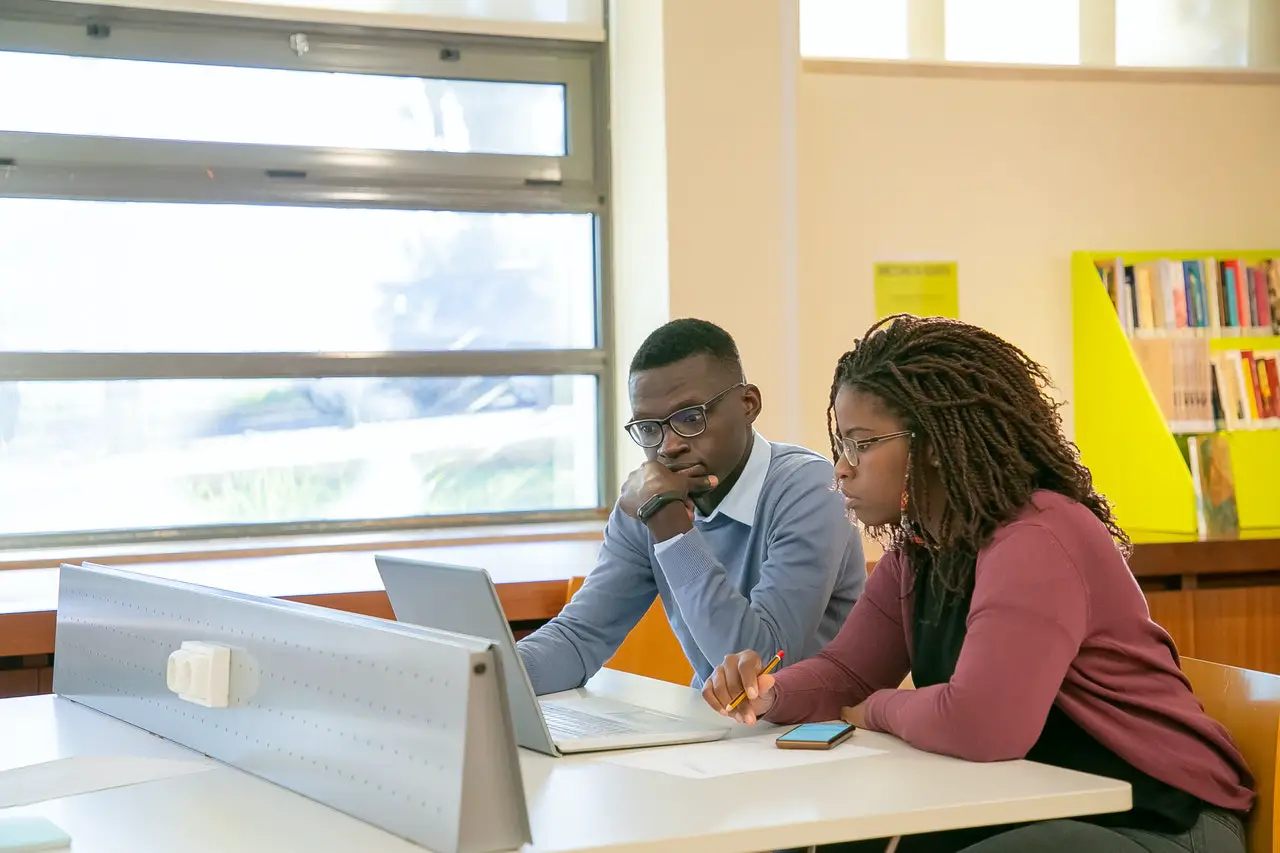
Critical thinking skills are vital in allowing you to find answers to questions or problems that you have not previously encountered. Memorization may not provide the necessary ability to solve any issue that deviates from the memorized material.
Another term often used in education, meaningful learning is a way of describing the learning that occurs when students can use both their knowledge base and cognitive skills, such as critical thinking, that they have been practicing for successful problem-solving.
Meaningful or “Deep” Learning
When considering rote learning vs critical thinking it’s important to remember that when we lean too heavily on memorization it can obstruct deeper learning. Often most of the information learned through memorization alone is later lost.
The reason for this is that our brains can only hold so much information. Each time a new piece of information is introduced our brains have to make a decision about how relevant that piece of information is. If we don’t use the newly acquired information in a meaningful way our brains have no reason to keep it around and it is not transferred to long-term memory.
Back to Critical Thinking
The problem-solving skills created through the practice of critical thinking are vital to the exercise of meaningful learning. To come up with both creative problems to apply your knowledge to, and the solutions to those problems requires critical thinking to evaluate your ideas and be able to select the best ones.
A skilled critical thinker can separate opinion from fact and knows how to examine an issue from multiple angles. They can withhold their judgment while gathering facts and can make rational inferences to come to a logical conclusion.
Rote learning by definition does not involve critical thinking at all and does not require understanding. This is why when the question of rote learning vs critical thinking comes up many modern educators and scholars condemn the practice of rote learning.
Critical thinking skills should be fostered from an early age. A child who develops the ability to distinguish opinion from fact and creatively solve problems will build confidence and self-respect that will benefit them their whole lives.
In Conclusion
Both rote learning and critical thinking have important roles to play in education.
Although rote learning is discounted by many educators today, it shouldn’t be left out entirely. Rote learning can be useful in memorizing certain facts to make space in our working memories for learning new concepts related to those facts.
Critical thinking is by far the more important skill as the problem-solving abilities it fosters will serve a person well in most aspects of their daily lives in education, career, and basic life skills.
https://yangon.dulwich.org/lp/teaching-problem-solving-skills#:~:text=Critical%20thinking%20is%20self%2Ddirected,and%20self%2Dcorrective%20thinking.%E2%80%9D&text=Whereas%20rote%20learning%20tends%20to,alternatives%20they%20can%20discover%20themselves.
https://www.sciencedaily.com/releases/2006/11/061128084444.htm#:~:text=memory%20loss%3A%20memorization.-,Researchers%20found%20that%20seniors%20who%20engaged%20in%20an%20intensive%20period,improved%20memory%20and%20verbal%20recall.&text=The%20researchers%20studied%20how%20repeated,brain%20cells%20involved%20in%20memory.
Rote Learning vs. Critical Thinking: How an Online Math Tutor Can Help
https://www.linkedin.com/pulse/what-importance-benefits-critical-thinking-skills-islam#:~:text=Critical%20Thinking%20enhances%20language%20and,thinking%20also%20improves%20comprehension%20abilities.
You may also like

What is logical thinking
We observe many things in our life with intention or without. This is the usual tendency of all human beings from all […]

How to answer critical thinking questions
Whether you are studying and preparing to take the LSAT or looking to engage in more meaningful workplace discussions, you need to […]

Masterclass vs Coursera: An In-depth Comparison for Eager Learners
Choosing the right online learning platform can be a crucial decision for individuals seeking personal development, career advancement, or acquiring new skills. […]

Lateral Thinking in the Real World: Everyday Examples of Lateral Thinking.
The history of art, science, politics, warfare and business are full of examples of lateral thinking. Nelson’s famous victory at the Battle of […]
Rote Memorization and Learning Techniques

There are two types of cells: _____ and ______.
The states are Alabama, Alaska, Arizona, Arkansas…
You might be singing songs as you pull up this information in your head. You might be thinking about a flashcard you used in grade school before a quiz. The goal of these exercises and study games became to memorize the information.
You probably repeated these exercises, quizzes, and other study techniques repeatedly. During this time, you were engaging in a practice called rote memorization.
In this discussion, I’ll discuss rote memorization, why it’s highly debated among educators, and how to use it effectively. Rote memorization alone will not make you a genius, but it can help to set a solid foundation for evaluation, creation, and other high-level thinking skills.
What is rote memorization?
Rote memorization, or rote learning, is learning through repetition and memorization. The goal of rote memorization is to be able to recall information once it is presented to you instantly.
Four! You probably didn’t have to think about the answer. But this is only after years and years of hearing your parents, teachers, or characters on television tell you that 2+2 is 4. This is a successful case of rote memorization.
Throughout this page, I’ve mentioned a few ways we learn through rote memorization. Everyone also has their own unique tricks. You have also probably used a handful of these at the suggestion of teachers, parents, or study buddies:
- Using mnemonic devices
- Singing songs to learn information
- Repeatedly solving the problem (spelling the same word repeatedly, taking many multiplication tests, etc.)
Rote memorization vs critical thinking (difference between memory and intelligence)
Learning strategies often generate significant curiosity. Among these, the merits and demerits of rote memorization are frequently debated. Recently, with standardized tests becoming a predominant measure of a student's academic success, rote memorization, which focuses on learning through repetition without necessarily understanding the context, has faced criticism.
Memorizing a list of definitions for a test poses a question: Does recollection equate to genuine understanding?
Many educators advocate that relying solely on rote memorization can be detrimental. When the focus shifts to just "teaching to the test," students may miss out on developing crucial critical thinking skills . For example, while recalling that 12 x 12 equals 144 is handy, it's more impactful to understand the concept of multiplication, the logic behind it, and its application in various scenarios.
Similarly, simply naming all 50 states doesn't provide as profound an insight as exploring each one's unique culture and geography. Regurgitating facts isn't sufficient in real-world situations, especially in professional environments. True problem-solving demands critical thinking: the ability to analyze, evaluate, and innovate. This often involves experimenting, learning from mistakes, and applying a more profound understanding to find solutions.
When is rote helpful learning? (short time frame or foundational information)
Rote memorization is one of many techniques available for acquiring new knowledge. While it focuses on repetition and memorizing facts verbatim, critics argue that it doesn't promote the depth of understanding and hands-on skills offered by experiential or project-based learning methods. In discussions on pedagogy, some contrast "rote learning" with "meaningful learning," inadvertently suggesting that the former lacks depth or relevance.
However, dismissing rote memorization as merely an "old" or "outdated" strategy would be a misunderstanding. In truth, it has its own merit and place in the learning process. When utilized appropriately, rote memorization can lay the foundational knowledge required before engaging in more interactive or hands-on learning experiences. Think of it as building the base of a pyramid, wherein experiential or project-based techniques can then enrich and expand upon that established knowledge.
Building a Foundation
In 1956, educational psychologist Benjamin Blo om created a hierarchy that classified higher-level and lower-level thinking. The hierarchy was built as a framework to help educators classify their goals for teaching students.
At the top of the hierarchy is “synthesis,” which psychologists have revised to “creation.” Creation includes all the higher-level skills you might expect: generating new ideas, planning a strategy, etc. Alongside creation is “evaluation.”
At the bottom of the hierarchy is “knowledge” or “remembering.” The skills required to display this level of thinking include recalling facts, recognizing and describing patterns, and memorizing information.
Like most hierarchies, the top cannot exist without the bottom. In Maslow’s Hierarchy of Needs, we cannot obtain self-actualization without physical needs like food and shelter. The same principle applies to Bloom's hierarchy. We cannot evaluate and transform facts into something new without memorizing and recalling facts.
It’s challenging to think about taking a calculus class without the ability to know basic multiplication tables. Even if you did know how to use a calculator to add, divide, and subtract, higher-level math classes would be frustrating and tedious without the knowledge of 2+2.
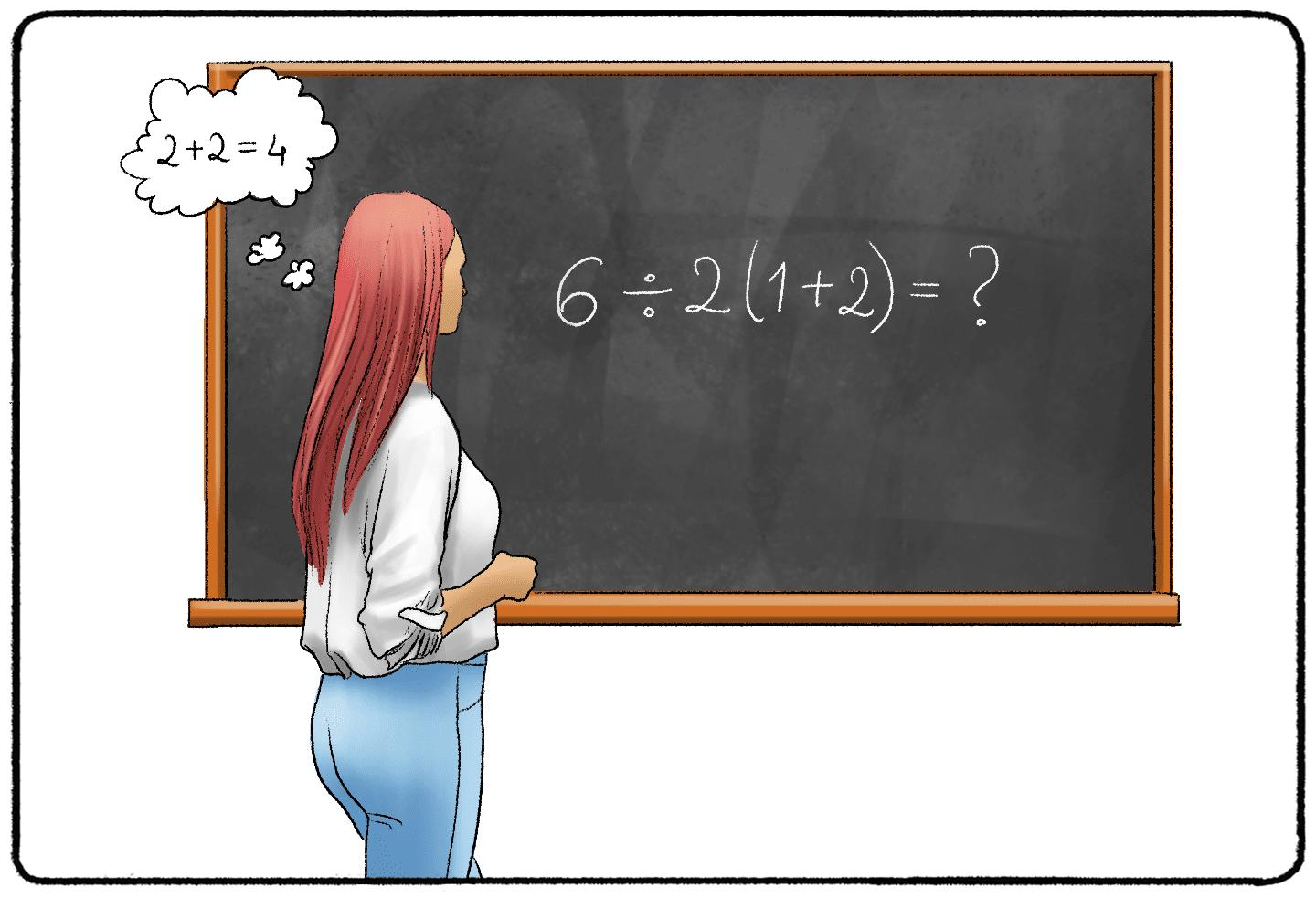
Recalling the tunes you sang to conjugate verbs in a second language is a prime example of rote memorization at work. Such melodies and repetitive chants embed information in our memory, serving as foundational blocks. This foundation is essential, for without it, our broader understanding and application of knowledge would be unstable, much like a pyramid built on shaky ground.
Learning in a Short Time Frame
Rote memorization is the fastest way to learn something. Period. If you want to ensure that tomorrow’s test will memorize the capital of Japan, memorize it. Experiencing the culture of Japan or understanding how you can find the capital of Japan are great strategies, but unless you can Google the capital of Japan during your test tomorrow, you probably won’t be able to recall it.
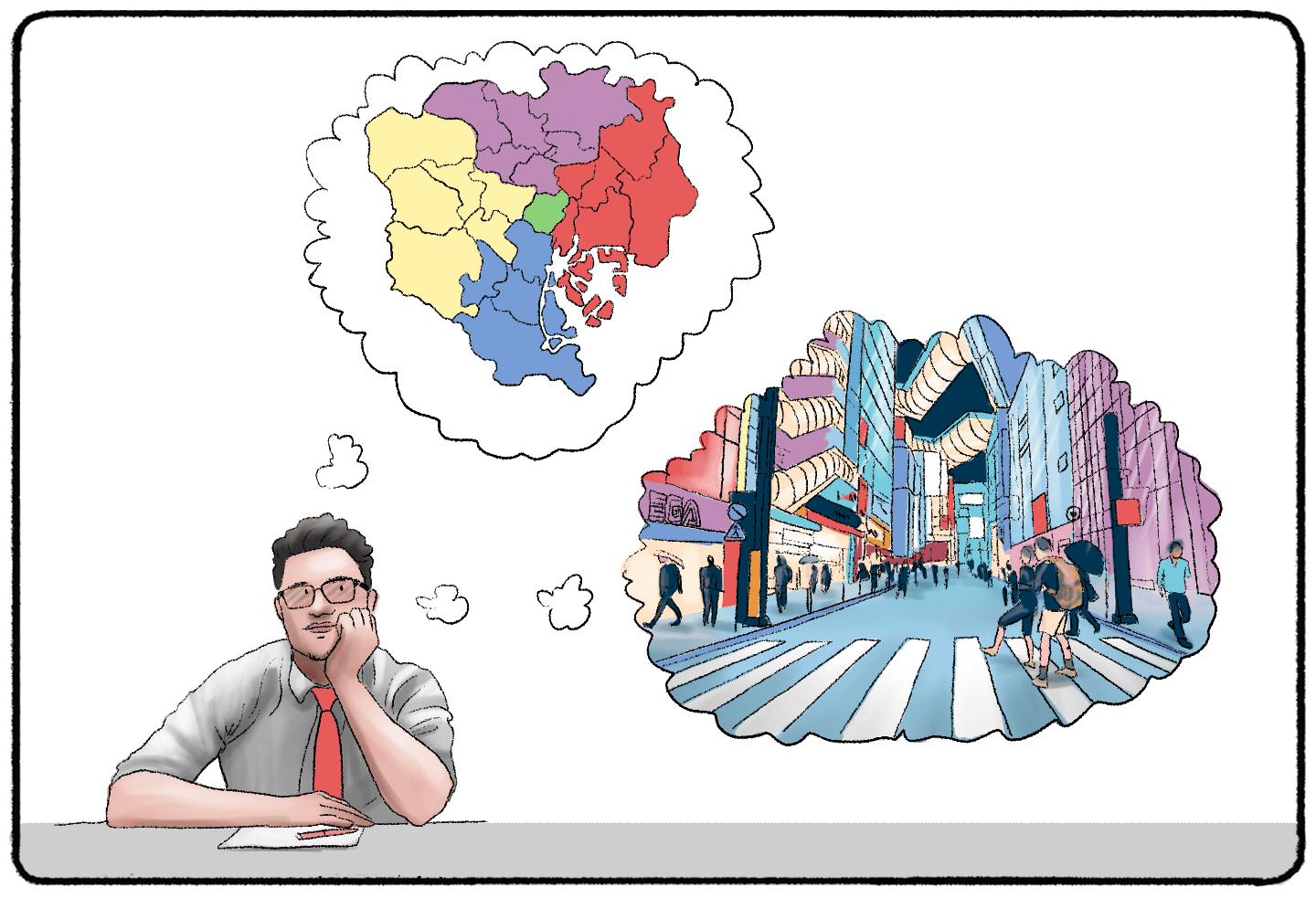
The critical lesson to take away from this video is that it’s essential to strike a balance between simply memorizing information and applying it to higher-level learning strategies. Rote memorization can quickly establish a piece of foundational knowledge, but merely recalling facts doesn't demonstrate a deep understanding of a subject. To be an expert on Tokyo, you will have to do much more than just knowing that it’s the capital of Japan.
When you sit down to learn a subject, think about your goals. What do you need to know? What skills do you need to possess to get there? And what strategies will help you best retain what you need to learn?
Related posts:
- The Psychology of Long Distance Relationships
- Beck’s Depression Inventory (BDI Test)
- Operant Conditioning (Examples + Research)
- Variable Interval Reinforcement Schedule (Examples)
- Concrete Operational Stage (3rd Cognitive Development)
Reference this article:
About The Author

Operant Conditioning
Classical Conditioning
Observational Learning
Latent Learning
Experiential Learning
The Little Albert Study
Bobo Doll Experiment
Spacing Effect
Von Restorff Effect
PracticalPie.com is a participant in the Amazon Associates Program. As an Amazon Associate we earn from qualifying purchases.
Follow Us On:
Youtube Facebook Instagram X/Twitter
Psychology Resources
Developmental
Personality
Relationships
Psychologists
Serial Killers
Psychology Tests
Personality Quiz
Memory Test
Depression test
Type A/B Personality Test
© PracticalPsychology. All rights reserved
Privacy Policy | Terms of Use
- Bipolar Disorder
- Therapy Center
- When To See a Therapist
- Types of Therapy
- Best Online Therapy
- Best Couples Therapy
- Best Family Therapy
- Managing Stress
- Sleep and Dreaming
- Understanding Emotions
- Self-Improvement
- Healthy Relationships
- Student Resources
- Personality Types
- Guided Meditations
- Verywell Mind Insights
- 2023 Verywell Mind 25
- Mental Health in the Classroom
- Editorial Process
- Meet Our Review Board
- Crisis Support
Does Rote Memorization Actually Help Us Learn New Things?
Memorizing information can be effective...sometimes
Ariane Resnick, CNC is a mental health writer, certified nutritionist, and wellness author who advocates for accessibility and inclusivity.
:max_bytes(150000):strip_icc():format(webp)/pinkhair-809ed47ad1e844c5b9d25667f1095e62.jpg)
Su Arslanoglu/E+/Getty
What Exactly Is Rote Memorization?
- Does Rote Memorization Help Us Learn?
Disadvantages of Rote Memorization
- What's the Difference Between Rote Memorization and Meaningful Learning?
We've all experienced it: You have important information you need to remember, and you'll do anything it takes to keep it at the forefront of your brain. In this situation, rote memorization may be your best—or even your only—option. But are you really accomplishing much?
If you've ever employed rote memorization, you've probably wondered whether or not it accomplished you much in the long term.
At a Glance
Rote memorization is the act of repeating information until you remember it. A great example of that is memorizing someone's phone number. It's not about any sort of deep learning, and memorizing information doesn't mean you understand it.
Advantages of rote learning include that it's helpful for test preparation , and disadvantages include that you won't necessarily remember the info you memorized long term. Rote memorization has its place, but it's not nearly as valuable as meaningful learning.
Rote memorization is when we repeat a piece of information until we remember it. One great example of it is the alphabet. When we are little, we don't necessarily understand that our language is composed of the letters A to Z. But we memorize them in a specific order because we are taught to, and then we know the alphabet.
Anything can be memorized through repetition. You may know history facts, multiplication tables, the Pledge of Allegiance, or even how to do your job through rote memorization. It's a form of learning , but it doesn't signify deep understanding of a topic. It's simply the act of repeating something enough times that eventually, our brains hold on to it.
Does Rote Memorization Actually Help Us Learn and Understand Information?
There are situations in which rote memorization can be helpful. "Rote memorization can be a useful learning tool in some situations, but its effectiveness depends on the type of information being learned and how it is applied," says Dr. Aldrich Chan , neuropsychologist. He tells us that rote memorization can be a useful learning tool for test preparation, learning basic facts and information such as vocabulary words or math formulas, and when we are in the early stages of learning something new.
Of course, rote memorization is not akin to strong understanding, and memorizing facts doesn't mean you've actually learned a subject. Chan notes that "rote memorization often does not promote a deep understanding of the material. Learners may be able to recite facts or information without truly comprehending their meaning or significance."
These Are the Benefits of Rote Memorization
Rote memorization has a place in our day to day lives, especially when we need to learn something new or in a quick fashion. It enables us to regurgitate information in situations where doing so is the main thing asked of us, even if it doesn't lead us to have a deep understanding of that info. Here are its top benefits:
- Easy access to info: Chan says that "rote memorization helps you quickly recall essential facts, data, or formulas. This can be particularly helpful in situations where immediate access to information is required, such as during exams or for a job roles."
- Efficiency: When you need to know someone's phone number, it doesn't really require you to understand it—you just need to get your brain to access a series of numbers. Chan tells us that "for some types of information...memorization is often more efficient than trying to derive the information through other means. Memorization can save time and mental effort for frequently used data."
- Your mind is engaged: Memorization is better than simply not using your brain. A study found that older adults who employ rote memorization have stronger neural plasticity than those who don't.
- Preserving culture: The written word has not always existed, and even now there are people who may not have access to paper or the internet. Chan explains that "memorization has been a traditional method for preserving cultural and historical knowledge. Oral traditions, epic poems, and religious texts have been passed down through generations via memorization."
The act of memorizing through repetition, as you may suspect, also has its down sides. This is why it isn't always the solution to every problem. These are the disadvantages of rote memorization.
- Lack of Retention: Memorizing facts through repetition doesn't necessarily keep them in your brain for long. "Information memorized through rote learning is often retained in the short term but may be forgotten relatively quickly if not actively used," says Chan.
- Shallow Understanding: You don't necessarily get much depth out of rote memorization. Says Chan, "one of the most significant drawbacks of rote memorization is that it often does not promote a deep understanding of the material. Learners may memorize facts or information without truly comprehending their meaning or how they fit into a broader context."
- It Doesn't Benefit Your Mind: Rote memorization can't teach you how to think for yourself. "Rote memorization tends to focus on memorizing facts and procedures, which may discourage critical thinking or problem-solving skills," explains Chan.
What's the Difference Between Rote Memorization and Meaningful Learning?
Both rote memorization and meaningful learning have their place. The most important thing to remember is that they are different, and rote memorization cannot stand in as a substitute for actual learning. Just because you have memorized something doesn't mean you understand it, and it doesn't mean that you can do anything with that information beyond recite it.
The uses for rote memorization are not as vast as they are for deep learning. Says Chan, "rote memorization involves repeating and memorizing information without a deep understanding of its meaning, often leading to short-term retention and limited application." On the other hand, he explains that "meaningful learning focuses on understanding the underlying concepts and principles, encouraging critical thinking, and facilitating the integration of knowledge into broader contexts. Meaningful learning promotes long-term retention and the ability to apply knowledge flexibly."
If you have a big test coming up or a list of attendees to memorize for a party, if may be helpful for you to utilize rote memorization. It can't replace meaningful learning, but it has its place.
Ahmed A, Ahmed N. Comparative analysis of rote learning on high and low achievers in graduate and undergraduate programs. Journal of Education and Educational Development . 2017;4(1):111-129.
Roche RA, Mullally SL, McNulty JP, et al. P rolonged rote learning produces delayed memory facilitation and metabolic changes in the hippocampus of the ageing human brain. BMC Neurosci . 2009;10:136.
By Ariane Resnick, CNC Ariane Resnick, CNC is a mental health writer, certified nutritionist, and wellness author who advocates for accessibility and inclusivity.
- Child Program
- Adult Program
- At-Home Program
Take the Quiz
Find a Center
- Personalized Plans
- International Families
- Learning Disorders
- Processing Disorders
- Oppositional Defiant Disorder
- Autism Spectrum Disorder
- Behavioral Issues
- Struggling Kids
- Testimonials
The Science Behind Brain Balance
- How It Works
Rote Memorization and Critical Thinking
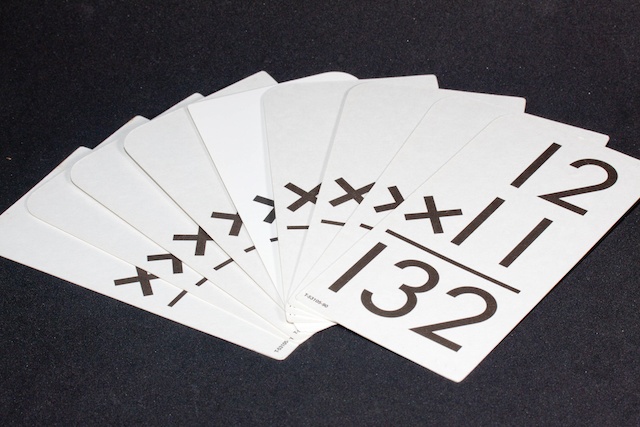
Does rote learning compromise or assist a student's ability to think through problems?
Children with neurobehavioral challenges experience unavoidable physical and biological challenges in the classroom, so it’s crucial to make sure these students are not burdened with additional obstacles presented by an inappropriate teaching method. In this era of standards-based education, schools are feeling pressure to prepare students for testing, and this pressure tends to result in more rote memorization. Are critical thinking skills being overlooked in schools today? Parents need to be aware of the following three touchstones in order to engage in productive conversations with their children’s teachers:
Critical thinking is undervalued for all students
“The United States ranks 24th out of 29 developed countries in critical thinking,” according to research cited by University of Texas at Dallas neuroscientist Dr. Sandra Bond Chapman . She goes on to explain: “This is a problem across the nation. We’re missing the critical brain years and building a brain that doesn’t reason.”
Dr. Chapman feels that students with ADHD are especially vulnerable to this critical thinking deficit, regardless of their intelligence. However, the relationship between memorization and problem-solving strategies is not a simple one-or-the-other type of opposition.
Memorization is a cornerstone of critical thinking
William R. Klemm, PhD , senior professor of neuroscience at Texas A&M University, points out: “We think and solve problems with what is in working memory, which in turn is memory of currently available information or recall of previously memorized information . . . Numerous studies show that the amount of information you can hold in working memory is tightly correlated with IQ and problem-solving ability.”
In his explanation of the ways in which memorization trains the brain, Dr. Klemm explains that strategies must be developed to facilitate the essential art of memorization. Other neuroscience research also supports this idea, with researchers finding that, “as young math students memorize the basics, their brains reorganize to accommodate the greater demands of more complex math.”
Brain development affects the foundations of learning
Rote learning can be an important tool in building a foundation for higher-level critical thinking skills. However in students who struggle academically with conditions like ADHD and learning disabilities, this approach can be challenging. Poor working memory is common in children with ADHD due to their tendency towards distraction, which can lead to a weakened ability to think critically about a problem.
Dr. Robert Melillo , one of the founders of the Brain Balance Centers, has published research demonstrating that children who struggle with ADHD and other learning disorders are actually showing evidence of weak brain function in the left or right hemispheres. When these children receive extra help that targets and strengthens the area of their individual delay, they are able to catch up with their peers and experience new learning success.
If your child has poor working memory and needs to improve his or her executive function skills, we invite you to consider The Brain Balance Program. Once we determine which brain processes are under-developed through our comprehensive assessment, we create a customized plan for your child to improve neural connections and lay the foundation for proper brain development. Contact us today to learn more!
Enjoy These Related Articles Improving Executive Function Skills Studies Show Exercise Helps ADHD Kids Kid Friendly Foods That Support Memory
Get started with a plan for your child today.
Related posts.
By Dr. Rebecca Jackson
What is Dyslexia?
Brain-healthy chicken pot pie.
Gluten-Free, Dairy-Free, Brain-Healthy Chicken Pot Pie Recipe
Call us at 800.877.5500
Webinar Sign Up
Call 800-877-5500

Rote Learning
December 8, 2023
The basics of rote learning: a method focused on memorization through repetition, ideal for mastering fundamental facts and figures.
Main, P. (2023, December 8). Rote Learning. Retrieved from www.structural-learning.com/post/rote-learning
What is Rote Learning?
Rote learning is a memorization technique that involves repeating information over and over until it is committed to memory . It is often associated with the traditional style of education, where students are expected to simply repeat information without truly understanding it.
Rote learning is commonly used to remember facts, formulas, and other important details, but it is often criticized for not promoting deeper comprehension or critical thinking skills. In this article, we will explore the concept of rote learning, its potential benefits and drawbacks, and alternative learning strategies that may be more effective in the long run.
Rote learning is a method that involves the memorization of specific information through repetition. The primary benefits of rote learning include its effectiveness in memorizing specific information such as dates, facts, or figures.
This method can also be useful in learning music scales or historical dates. Rote learning can be advantageous for adults in certain contexts, such as when they need to quickly recall specific information in their professional lives.
For example, medical professionals may benefit from rote learning when memorizing drug dosages or the symptoms of particular diseases. Additionally, adults learning a new language may find rote learning helpful for memorizing vocabulary and grammatical rules.
The benefits of rote learning include its effectiveness in memorization and its usefulness in certain contexts for adults in professional and educational settings.
Examples of Rote Learning
As we have seen, rote learning is a traditional memorization technique where information is repeated until it's firmly memorized. It's often employed in educational settings to help children and students embed basic knowledge.
Concrete Examples of Rote Learning include:
- Spelling Games :
- Children learn to spell words correctly through repetitive practice.
- Games might involve spelling out words aloud or writing them multiple times.
- Repetition of the Alphabet :
- Helps young learners remember the sequence of letters.
- Activities may include singing the alphabet song or tracing letters.
- Memorizing Multiplication Tables :
- Students recite and practice multiplication facts repeatedly.
- This could involve oral repetition, written exercises, or interactive apps.
- Memory Games :
- Enhance recall through visual and associative memory techniques.
- Examples include matching cards with words and images or using flashcards.
- Multi-Sensory Rote Learning :
- Combines visual, auditory, and kinesthetic elements to enhance memorization.
- Activities might involve moving to a rhythm while reciting or using colorful visual aids.
Incorporating these techniques, educators can make rote learning more engaging and effective, helping students to firmly grasp foundational knowledge.
Techniques of Rote Learning
Rote learning, also known as memorization or repetition learning, is a technique that involves the memorization of information through repetition without necessarily u nderstanding the meaning or significance of the information.
This method has been used for centuries in education and has been a common practice in many cultures. There are various techniques and strategies that can be employed to enhance the effectiveness of rote learning, and understanding these methods can be beneficial in educational settings .

Memorization Technique
The memorization technique discussed in the next heading emphasizes the importance of rote repetition for strengthening memory and long-term retention. Rote repetition involves repeating information over and over again until it becomes ingrained in long-term memory. This process is crucial for committing information to memory and allowing for automatic processes to take over, freeing up working memory for more complex higher-order skills .
Committing information to long-term memory has many benefits, as it allows individuals to cheat the limitations of working memory . Once information is stored in long-term memory, it can be accessed and utilized without the need to constantly rehearse or hold it in working memory. This process is essential for more complex cognitive tasks and activities that require deep conceptual understanding and problem-solving skills.
Rote repetition plays a critical role in strengthening memory and long-term retention, while also freeing up working memory for higher-order skills . Committing information to long-term memory is essential for overcoming the limitations of working memory and allowing for more advanced cognitive processes to take place.
Spaced Repetition Technique
Spaced repetition is a learning technique that involves spacing out review of material over increasing intervals of time. This method has been shown to improve knowledge retention compared to traditional learning methods.
In elearning , spaced repetition can be integrated by using algorithms to schedule review sessions of previously learned material at optimal times. This allows learners to remember information more effectively and for longer periods of time.
Many Elearning platforms utilize spaced repetition by incorporating features such as personalized quizzes and flashcards. These tools prompt learners to review information at specific intervals, reinforcing their memory of the material. This integration enhances the overall learning experience, leading to improved knowledge retention and long-term recall.
In the workplace, spaced repetition can be used to enhance rote learning by systematically reviewing important information at regular intervals. This ensures that employees retain critical knowledge and skills necessary for their roles.
By incorporating spaced repetition into workplace learning, organizations can improve the effectiveness of training programs and enhance employee performance.
Overall, the spaced repetition technique in elearning offers significant benefits for knowledge retention and can be effectively utilized to enhance rote learning in the workplace.
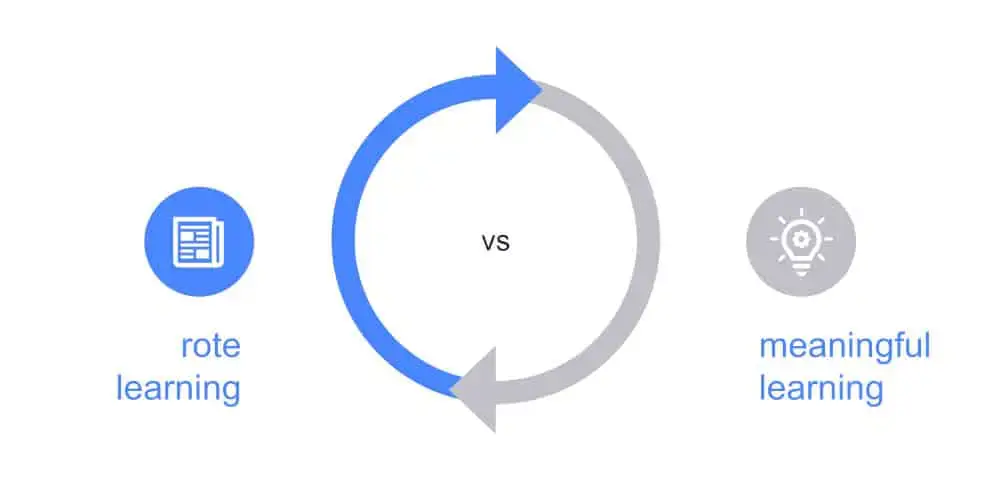
Rote Learning Vs Critical Thinking
In the landscape of secondary education, a balance between rote memorization and critical thinking is essential for meaningful learning. Teachers often navigate this terrain, recognizing that while active learning strategies engage students in higher-order thinking, foundational knowledge—sometimes built through rote learning—serves as the bedrock for such critical engagement.
The journey from memorizing facts to applying them in complex ways mirrors the cognitive development stages outlined in educational psychology . Rote memorization, although sometimes viewed as mechanical, equips students with the necessary vocabulary and basic concepts that form the scaffold for critical analysis and synthesis.
It is this interplay of acquiring knowledge and then using it as a tool for deeper inquiry that constitutes the heart of meaningful learning.
In Special Education , this dynamic is especially pertinent; educators must tailor their approaches to ensure that students with diverse learning needs can access and apply knowledge in ways that resonate with their unique learning profiles.
Engaging students in critical thinking does not negate the importance of rote learning; instead, it emphasizes the need for a firm grasp of fundamental knowledge before one can evaluate, infer, or create anew. This cognitive groundwork is not just a stepping stone but a vital component of the educational process.
As such, educators aim to transcend the dichotomy of rote versus critical thinking, acknowledging that one feeds into the other. By fostering an environment where rote memorization acts as a precursor to critical thinking, teachers empower students to not only understand but also to question and extend their knowledge.
Active learning, therefore, is not just about interaction and engagement, but also about ensuring that students have the necessary knowledge base to participate in such a dynamic educational experience fully.

The Role of Rote Learning in the School Curriculum
In the fabric of 21st-century education, the role of rote learning is nuanced, with its suitability varying across different types of knowledge within the curriculum.
Epistemology , the theory of knowledge , suggests that certain cognitive skills benefit from the foundational support provided by rote learning.
When children commit basic facts to memory, they create a framework of previous knowledge that can be accessed for more complex tasks. This method can be especially beneficial in Special Education , where rote learning supports the development of memory pathways, aiding students who thrive as rote learners.
In secondary education, while the focus is increasingly on meaningful learning and deep understanding, there remains a clear place for rote learning.
Types of Knowledge Suited to Rote Learning:
- Times Tables : Mastery of multiplication through rote learning facilitates more advanced mathematical problem-solving .
- Spelling : Memorizing correct spellings lays the groundwork for effective communication and deeper literacy skills.
- Historical Dates : Knowing key dates allows students to place historical events within a broader context.
- Scientific Terminology : Familiarity with technical terms is essential for engaging with complex scientific concepts.
- Geographical Facts : Countries, capitals, and physical features form the basis for more elaborate geographical studies.
- Language Vocabulary : Building a bank of vocabulary through rote learning is fundamental for language acquisition.
Rote learning, when employed effectively, can anchor students' learning experiences, providing them with the necessary tools to engage in higher-level cognitive tasks . It acts as a stepping stone towards achieving a comprehensive educational journey.

Does the Rote Method Of Learning still play a role?
As we have explored, the rote method of learning is a traditional approach that involves memorizing information through repetition without necessarily understanding the underlying concepts. This method has been a subject of debate among educators, with proponents arguing that it is an effective way to quickly and efficiently memorize facts, while critics claim that it hinders deeper understanding and critical thinking skills.
In this section, we will explore the advantages and disadvantages of using the rote method of learning.
Advantages Of Using The Rote Method Of Learning
While rote learning is instrumental in building a base of knowledge, it's part of a broader educational strategy that includes critical thinking and creative problem-solving to foster a comprehensive understanding.
- Quick Recall of Facts : Rote learning enables students to memorize and recall information rapidly.
- Foundational Knowledge : It lays the groundwork for deeper understanding in various subjects.
- Order and Sequence : This method is effective for learning sequences like the alphabet and multiplication tables.
- Retention of Lists : Students can use rote learning to remember lists, such as historical events in chronological order.
- Vocabulary Acquisition : Memorizing vocabulary words is facilitated through rote techniques.
- Key Date Memorization : Rote methods assist in learning significant dates relevant to a subject.
- Formula Retention : It is useful for ingraining mathematical and scientific formulas in memory.
Disadvantages Of Using The Rote Method Of Learning
Recognizing these disadvantages is crucial for educators to balance rote learning with more interactive and thought-provoking teaching methods.
- Superficial Understanding : Rote learning may lead to memorizing facts without grasping the underlying concepts .
- Short-Term Retention : Knowledge acquired through rote learning is often not retained over the long term.
- Lack of Engagement : This method can cause students to disengage from the learning process.
- Minimal Critical Thinking : Rote learning does not typically encourage analysis or synthesis of information.
- Poor Application : Students might struggle to apply memorized information to practical situations .
- Lack of Connections : The method fails to promote making connections between different pieces of information.
- Limited Creativity : Rote learning focuses on repetition, which can stifle creative problem-solving skills.

Rote Learning in Language Acquisition
Rote learning in language acquisition involves the memorization of vocabulary and grammar rules through repetition and rehearsal. This method can be challenging as it requires a significant amount of time and effort to commit information to memory. The process of rote learning can also be monotonous and may lead to a lack of meaningful understanding or application of the language.
However, rote learning can be beneficial in language acquisition as it provides a foundation for language skills and helps learners to quickly memorize new vocabulary and grammar rules. It also encourages consistent practice, which can improve fluency and proficiency in a language.
One drawback of rote learning is the potential for forgetting over time , as information that is not regularly reinforced may be lost. Additionally, the reliance on rote learning may hinder adaptability in using the language in real-life situations.
Overall, while rote learning can aid in memorization and initial language acquisition, it is essential to supplement this method with other approaches to ensure a deeper understanding and long-term retention of language skills .
The Neuroscience Behind Rote Learning
Rote learning is deeply rooted in neuroscience . When we repeatedly practice a certain activity or information, the connections between neurons in the brain are strengthened, resulting in more efficient retrieval of that information.
However, a potential downside of rote learning is the potential for a large database size, as every piece of information we learn adds to our memory store. This can result in slower recognition speed and increased difficulty in accessing specific information .
To address this, a compensating mechanism of forgetting is essential in learning. This allows the brain to clear out unnecessary information and make room for new learning.
Neural networks have the potential to address the challenges of rote learning by mimicking the brain's ability to process and store information. However, controlling their abilities is currently a major difficulty. While neural networks are capable of learning and adapting, they can also fall into the trap of overfitting and becoming too specialized in specific tasks, hindering generalizability.
Understanding the neural basis of rote learning and harnessing the power of neural networks holds promise for optimizing the learning process in the future.

Moving Beyond Rote Learning: Developing Higher-Order Thinking Skills
Rote learning has its limitations in that it focuses on memorization rather than deeper understanding. While rote learning can be useful for the acquisition of basic facts and information, it may hinder the development of higher-order thinking skills such as critical thinking and problem-solving.
Modern teaching methods like metacognition and associative learning provide alternatives to rote memorization by encouraging students to think more deeply about the information they are learning and make connections between different pieces of knowledge.
Educators can move beyond rote learning and foster higher-level thinking in their classrooms by incorporating strategies and techniques that promote critical thinking and problem-solving . This can be achieved through activities that require students to analyze and evaluate information, rather than simply memorize it.
Encouraging students to ask questions, think critically about the material, and apply their knowledge to new situations can help to develop their higher-order thinking skills. By embracing modern teaching methods and moving beyond rote learning, educators can help students achieve deeper understanding and meaningful learning.
Further Reading on Rote Learning
These papers provide diverse insights into the role and effectiveness of rote learning in various educational contexts, from language acquisition to programming and special education.
1. Prolonged Rote Learning Produces Delayed Memory Facilitation and Metabolic Changes in the Hippocampus of the Ageing Human Brain by R. Roche et al. (2009)
This study reveals that prolonged rote learning can enhance memory and promote neuronal plasticity, particularly for verbal/episodic material, in the aging brain. It underscores the importance of rote memory as a foundational skill for maintaining cognitive resources in advanced age.
2. Achieving Unconscious Recall of Kanji: Can Rote Learning Help ? by Dallas Nesbitt (2009)
Nesbitt's study highlights how guided rote-learning strategies can aid beginners in learning Japanese kanji. It suggests that rote learning builds neural pathways to procedural memory, playing a crucial role in the learning journey and facilitating recall.
3. Keyword Mnemonics Versus Rote Rehearsal : Learning Concrete and Abstract Foreign Words by Experienced and Inexperienced Learners by J. V. Hell, A. Mahn (1997)
This research compares the efficacy of keyword mnemonics and rote rehearsal in foreign language learning. It shows that for experienced learners, rote learning can be more effective than keyword methods, highlighting its role in developing higher-level critical thinking skills.
4. “Memo” Functions and Machine Learning by D. Michie (1968)
Michie's paper presents a perspective on rote learning in the context of programming language efficiency. It discusses how a simple rote-learning facility within programming can significantly improve the efficiency of programs during execution.
5. Facilitative Effect of Mnemonic Strategies on Multiple-Associate Learning in EMR Children by D. Ross, S. Ross (1978)
This study examines the effects of mnemonic strategies compared to rote repetition in improving learning in children with educational and mental retardation (EMR). It finds that imagery techniques are more effective than rote learning in enhancing multiple-associate learning.

Enhance Learner Outcomes Across Your School
Download an Overview of our Support and Resources
We'll send it over now.
Please fill in the details so we can send over the resources.
What type of school are you?
We'll get you the right resource
Is your school involved in any staff development projects?
Are your colleagues running any research projects or courses?
Do you have any immediate school priorities?
Please check the ones that apply.

Download your resource
Thanks for taking the time to complete this form, submit the form to get the tool.
Classroom Practice
- Prodigy Math
- Prodigy English
- Is a Premium Membership Worth It?
- Promote a Growth Mindset
- Help Your Child Who's Struggling with Math
- Parent's Guide to Prodigy
- Assessments
- Math Curriculum Coverage
- English Curriculum Coverage
- Game Portal
Rote Memorization vs. Meaningful Learning — Is There a Place for Both?

Written by Melanie Arden
- Teaching Strategies
What is rote memorization?
Does rote memorization work, what is meaningful learning, how to create meaningful learning in the classroom.
To this day, rote memorization is still popular in schools throughout the world. However, rote learning has a negative reputation of hindering student's creativity and failing the learning process in developing critical thinking skills.
Modern teaching methods such as metacognition, associative learning, meaningful learning, and critical thinking have taken the place of rote memorization. Metacognition appears to make an impact on how students learn mathematics.
In contrast to remote learning, associative learning is defined as "a learning principle that states that ideas and experiences reinforce each other and can be mentally linked to one another.” Examples of associative learning include how swimming may be connected to someone's fear of drowning or a misbehaving student who does not get to take part in a class activity as punishment.

Rote memorization requires the use of repetition to keep information in the brain.
Two simple examples of rote learning include memorizing the alphabet and numbers. As students transition into higher grades, multiplication charts and times tables are frequently learned through memorization.
There are several rote memory techniques that may help your students to remember most or all of what they've attempted to memorize:
- Tape flashcards throughout your home . Everywhere you turn, there are reminders posted in various sections of your home to help you remember key points.
- Record your notes and play them back. Audio learners find this method of rote memorization easy to use. It can help them remember smaller details during exams.
- Learning through the use of all five senses. Some students are visual learners, while others hold on to information better through audio means such as in-person lectures.
- Breaking down information into smaller easier-to-digest chunks. The human brain is incapable of memorizing large amounts of data at once. However, if students attempt to memorize shorter passages and numbers, it helps them to recall the information at a later date.
Rote memorization and rote learning are interchangeable terms that mean the same thing.
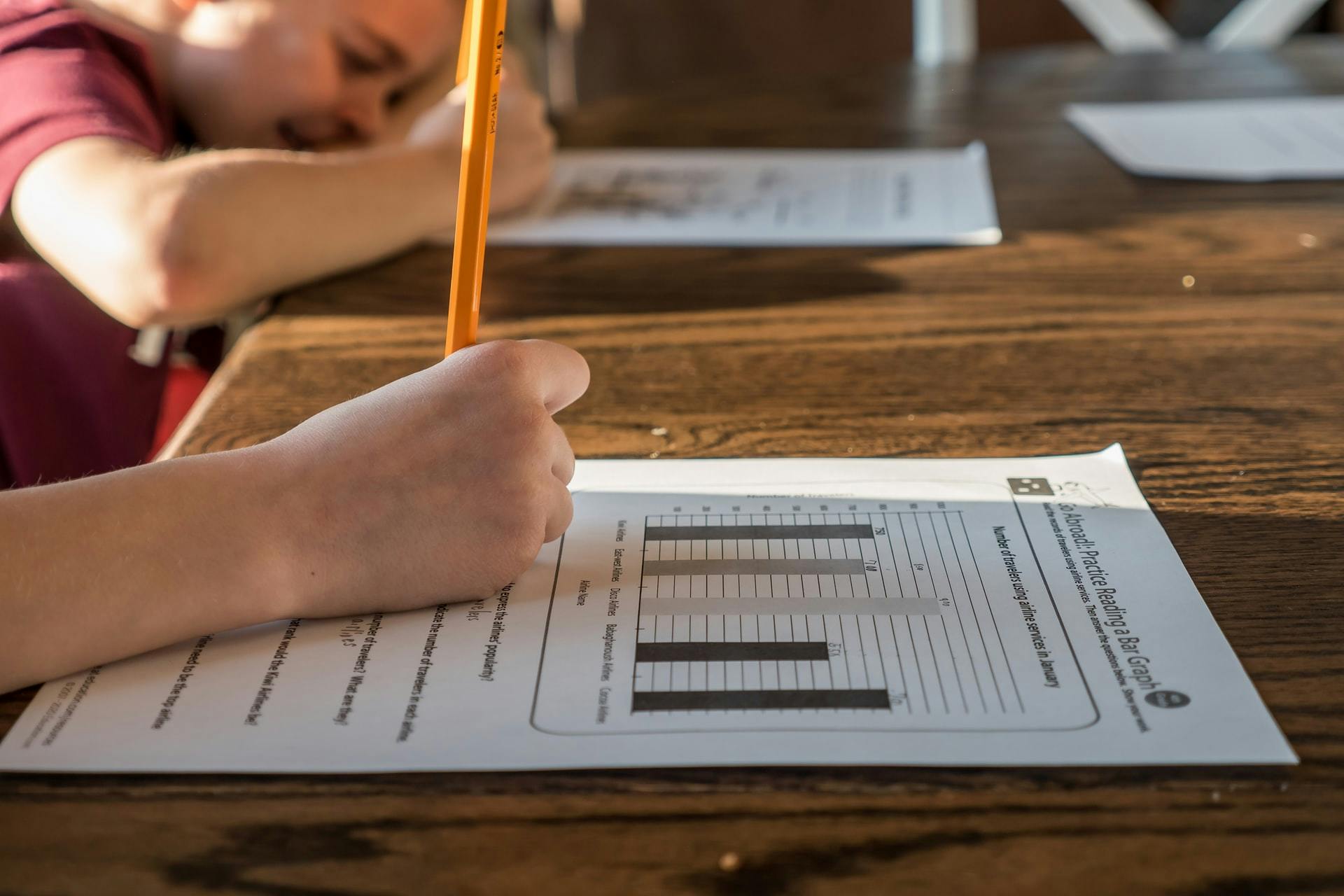
Rote learning has its own set of advantages and disadvantages. It has been effective in helping students learn basic mathematics like multiplication tables because:
- Purposeful rote learning tends to 'stick' more in students' minds vs. meaningless or random memorization
- It's a type of brain exercise that enhances neuroplasticity, improves memory and changes the way your brain works
- Rote learning has been shown to change the brain's structure and improve its ability to retain information for longer periods of time
Some educators believe memorization limits students' options and doesn't promote questioning and thinking. More disadvantages associated with rote memorization include:
- Easy loss of focus
- No use of social skills during rote learning
- Promotes short-term memory instead of long-term recall
- It's repetitive and tedious. Students may lose interest after a time
- It doesn't encourage students to grow, explore, and think out of the box
- Critical thinking skills do not have the chance to develop with memorization
Educators should incorporate some rote learning with other teaching methods to help their students remember valuable information.
The benefits of rote memorization
Rote memorization has several key benefits that could help students expand their learning capabilities. Students often feel a sense of accomplishment when they remember everything they memorized, whether it's poetry or multiplication tables.
Consider these benefits of rote learning:
- Memorized data stays within the student's short-term memory. However, the longer they keep this information in their mind, the greater the chance it will become part of their long-term memory.
- Rote learning is a type of "mental training" that helps students with future learning opportunities as they progress through subsequent grades. This level of training helps boost memory-retention capability.
- Students who discover rote memorization study strategies may find that they'll be able to increase the speed at which they're able to remember and hold information.
Playing new memory games such as picture bingo or ten-card memory recall may also help students strengthen their rote memorization skills. Older students can play Sudoku or Memorado — both are free to try.
The disadvantages of rote memorization

Cramming large amounts of specific details and facts may quickly become a laborious task for many students. The question remains — are they actually learning something or simply memorizing it to pass an exam?
- Rote memorization takes the fun out of learning something new.
- Students must use memory games and techniques to make the repetition stay put in their mind.
- There's no bridge between old and new concepts. In fact, knowledge-building is non-existent.
- Some students may find information retention difficult to master, whereas others will excel in this area.
- Social interaction is unlikely to occur between students because they'll be focused on memorization instead of working together.
- Students lose the ability to think for themselves because they're accustomed to following instructions. They cannot build leadership skills.
- Rote memorization does not promote critical thinking. Critical thinking skills could fall by the wayside if rote learning becomes your primary teaching method.
Many educators agree there is a place for rote memorization in the school system. However, most teachers have opted for other methods geared toward improving students' long-term memory and creating a more significant way to learn the course material.

Meaningful learning is defined as a method of gaining foundational knowledge and critical thinking by building on top of what was previously learned. Students make connections between the new information and older lessons.
There are five characteristics that make meaningful learning an effective teaching method: active, collaborative, constructive, authentic and goal-directed.
- Active learning involves students independently using technology regularly or self-directed.
- Collaborative learning means students team up while using conventional digital tools to complete assignments.
- Constructive learning focuses on using technology to build new information on top of knowledge received in the past.
- Authentic learning entails using digital tools to connect activities outside of the classroom setting.
- Goal-directed learning incorporates goals and activities with monitored tasks to finish homework assignments.
The primary goal of meaningful learning is to build cognitive skills that students will use for a lifetime. It is an effective means for students to engage in conceptual learning and build new skill foundations.
The benefits of meaningful learning
For meaningful learning to be effective, it's necessary for teachers to take into consideration students' previous knowledge. This type of learning benefits students tremendously:
- Teachers can focus on actual learning instead of memorizing content
- Learners build a deeper connection between new and old knowledge
- Students have a stronger ability to store knowledge in their long-term memory
- Kids have a better sense of purpose, motivation and achievement through meaningful learning
- Active learning involves getting new knowledge, problem-solving skills and critical thinking
To make good use of this technique, teachers can use examples, group activities and debates to create an environment conducive to learning.
The disadvantages of meaningful learning
While meaningful learning has significant benefits, there are several disadvantages for educators to think about before selecting this teaching strategy . The biggest downside is the requirement to build on a foundation of prior knowledge.
There are other disadvantages that teachers should consider:
- This technique does not work for information that needs to be recalled, such as phone numbers or historical data.
- Since this process requires effort, some students won't be interested in putting forth the time and energy into meaningful learning.
- If students do not find the new and old knowledge relatable, they won't be able to connect the two together. It may lead to frustration and loss of interest.
Educators may want to combine the use of rote memorization, meaningful learning, and other teaching methods to enhance students' ability to understand the course material.

Teachers can create meaningful learning so that students retain the lessons delivered in the classroom. Challenges include maintaining kids' interest and helping their knowledge 'stick'.
When educators adopt a student-centered approach to learning techniques, kids develop a connection to daily lessons. How can you connect students’ real-life experiences to your lesson plan? Reflect on the creative arts and storytelling that your students find relatable and exciting. It can also help them remember what they learned in class.
So what are other ways that teachers can help their students to recall what they've learned?
Linking content
A helpful way to get students to remember information is to connect their personal experiences to new concepts taught in class. Using students' relevant experiences and showing them how to link the two together enables them to remember details about what they learned in class.
Allowing students to figure out problems
Offer students feedback and positive encouragement when they make errors. They'll improve their ability to learn and hang onto knowledge gained in school. It's critical to their development to understand where they made mistakes and how to make corrections. If kids see mistakes pointed out to them without offering support or encouraging problem-solving, they may perceive this to be negative instead of something positive.
Giving students a chance to figure out problems on their own builds their confidence, self-worth and independence. It's a learning strategy worth exploring for your class.
Encouraging self-testing
Support your students by encouraging them to test their own knowledge. They'll build confidence in their own problem-solving abilities and reduce test anxiety. Provide study guides and quizzes so students can self-test their knowledge and feel assured they're improving their learning process.
It may be worthwhile for educators to incorporate surveys to determine how much knowledge their students retained.
Frequent assessments
Formative assessments can monitor and show evidence of students' learning. Kids benefit from improved long-term memory and develop a keen interest in whether they understood the course material.
The frequency of low-stakes assessments may ease "exam stress" and help students achieve mastery of the content they learned in class. When kids are exposed to regular testing, they become accustomed to receiving tests and feel less anxious.
Educators can take a bird's-eye view of whether their lessons are effective in getting students to understand each lesson. For example, if a teacher instructs their students in complex algebraic equations and a subsequent quiz reveals a lower-than-expected average, the teacher may want to adjust and simplify the content.
Frequent assessments help students and teachers gauge progress and correct any mistakes that occur throughout the school year. If a student lags in their understanding of the material, teachers can offer help before student comprehension declines.
Ongoing support with Prodigy
Want to move beyond rote memorization in your classroom? Try Prodigy Math Game!
Prodigy Math Game transforms math practice into an epic adventure , where students answer questions to earn rewards, complete quests and challenge friends. Prodigy’s adaptive algorithm makes sure students are always learning at a level that’s right for them, and encourages them to keep practicing relevant skills!
Free teacher tools help you easily send differentiated assignments, align in-game questions to your lesson plan and track student progress.
Classroom Q&A
With larry ferlazzo.
In this EdWeek blog, an experiment in knowledge-gathering, Ferlazzo will address readers’ questions on classroom management, ELL instruction, lesson planning, and other issues facing teachers. Send your questions to [email protected]. Read more from this blog.
‘Memorization Often Comes Without Understanding’

- Share article
(This is the final post in a two-part series. You can see Part One here .)
The new question-of-the-week is:
What is the appropriate role of student memorization in teaching and learning?
In Part One , Blake Harvard, Donna L Shrum, Keisha Rembert, and Sarah Cooper contribute their responses. You can listen to a 10-minute conversation I had with Donna, Blake, and Keisha on my BAM! Radio Show . You can also find a list of, and links to, previous shows here.
Today, Jason Batterson, Eric Jensen, and Carla Marschall finish up the series.
I published a post this past weekend sharing advice for how teachers might want to begin their distance/hybrid teaching year.
That post was just a “taste” of what is to come beginning on Aug. 1. You can expect to see at least 25 posts (and probably a lot more) in this column over the next two months answering many of the critical questions educators are asking themselves and others as we enter a potentially crazy year. And the responses will be coming from educators who have reflected on their own experiences of last spring, as well as what will have happened during the first few weeks of school this year.
But, first, here’s Part Two on memorization...
Math and memorization
Jason Batterson is the creator and lead author of the Beast Academy elementary math curriculum at Art of Problem Solving (AoPS). Before joining AoPS, he taught and coached math in Raleigh, N.C., coaching multiple team and individual state champions in algebra, geometry, and MATHCOUNTS. His first book, Competition Math for Middle School , has become a primary resource for introducing students across the nation to competition-level mathematics.
I can only speak to mathematics education, but I suspect many of the principles below apply to all areas of teaching and learning.
Students have a much easier time remembering things that they understand. Unfortunately, memorization often comes without understanding. For example, there are dozens of area formulas that students try to memorize by reading them from a list over and over again. They commit these formulas to memory for just long enough to pass the test, then move on to whatever they need to memorize next. These students are doomed to repeat the process a year later when the topic comes up again. On the other hand, students who can relate all of these formulas to just a few well-understood facts and principles have very little to memorize and can apply what they know moving forward.
Most students know how to find the area of a rectangle. If they can relate it to areas of other shapes like parallelograms, triangles, and trapezoids, they can often discover these area formulas on their own. Even better, if they can’t remember a formula for a particular shape, they can usually find its area by dividing it into pieces they understand. Building upon a solid foundation, students can move on to more complex shapes, even ones that are three-dimensional.

Formulas are not the only things students memorize at their peril. For many, math is learned as a series of steps to be memorized and repeated, over and over. You may remember learning a process like the one below for converting a mixed number into a fraction.

Students can perform these steps repeatedly without ever knowing why they work, and they can only apply them to a very specific type of problem. It’s much better for students to think through the conversion using what they know about fractions.

Notice that these steps require the same computations as before, but they give meaning to the steps. We multiply 4×5 because we want to convert 4 into 20 fifths. We add the 2 fifths we already had to get 20+2=22 fifths. Students who understand fractions this way are likely to discover the traditional algorithm on their own, and it’s much easier to remember something you’ve discovered.
Memorization, particularly when it comes to formulas and algorithms, is almost always unnecessary for the student who thoroughly understands a few basic concepts. These students can then apply what they know to a broad range of problems and situations.
Understanding One Key Exception:
There is one area where memorization is absolutely critical . As an 8th grade classroom teacher, there was one very accurate predictor of success that I used in my classroom every year: a timed multiplication-facts quiz. Students who struggle with multiplication facts are at an incredible disadvantage when it comes to virtually every skill taught in an 8th grade classroom.
Consider fractions. Why are fractions so difficult for so many students? For one thing, it’s virtually impossible to do anything with fractions if you don’t know your multiplication facts. Multiplying fractions is difficult for obvious reasons. Converting a mixed number to a fraction also requires multiplication. Adding two fractions with unlike denominators requires finding a common denominator, which is really frustrating if you don’t know your multiplication facts. Simplifying a fraction like 45/63? If you don’t know your multiplication facts, you don’t even notice that 45 and 63 are both divisible by 9.
If you’re a math nerd reading this who is still unconvinced, try a simple computation with fractions in any base other than 10. (For example, try simplifying 13/22 in base-5 without converting to base-10.) It’s really, really hard to wrap your mind around and gives a glimpse into the mind of a frustrated student who doesn’t know their times tables.
So, there is at least one area of mathematics where memorization is really important. But for the most part, math students should be doing very little memorization.

“The role of memory is critical!”
Eric Jensen is a former teacher who grew up in San Diego. With a Ph.D. in human development, he synthesizes brain research and is listed among the top 30 educators in the world at Global Gurus.org . He’s written over 30 books and co-founded an academic-enrichment program, held in 14 countries with over 70,000 graduates:
I have asked large groups of teachers, nationwide, over the last 10 years: “What are the biggest things that annoy you?” In the top three (their order changes) are consistently discipline issues, re-teaching, and getting kids to grade level. Many experienced teachers and trainers would tell you that all three are actually related.
How? They all three are common issues for teachers who come from the framework of: “I taught them, they just are not getting it.” Or, “Our content is what kids need to get.” I am sorry to say, they are wrong.
The short answer to the question at the top (in bold) is, “The role of memory is critical!”
I have written about, taught, and continue to teach teachers memory tools. They belong in our schools because of three things:
1) Memory is the residue (and evidence of) learning . Learning is the residue (and evidence of) teaching. What you teach is irrelevant; what students can show evidence of (memory) is everything. My question is, “How soon can you take ownership over the problem and start helping students perform better?”
2) Memory skills are part of a cluster of “Learn to Learn Skills.” Those skills include (among others), summarizing, retrieving, and critical reading. If you do not teach students memory skills, and reinforce what has been learned, why are you teaching anything? Effect sizes of memory are over the top! My question is, “How will students learn these skills unless you teach them?”
3) Memory can help students get to grade level. Kids who grow up in poverty (51 percent of those in public schools) underperform in five critical areas. Language is first, and the next two are both memory skills (long-term and working memory). Clear evidence shows chronic stress impairs declarative-memory formation. The question is, “How badly do you want your students to reach grade level or above?”
Yes, I am an absolute believer (and I say this in my books) that memory skills (short term, working memory, and long term) are ALL critical to teach. Anyone who thinks memory is unimportant should spend some time with a patient who has Alzheimer’s disease.

Memory must be integrated
Carla Marschall is experienced in P-12 curriculum development and implementation, having worked in a variety of curriculum leadership roles in international schools in Switzerland, Germany, and Hong Kong over the past 10 years. She currently works as the head of curriculum development and research at United World College of South East Asia in Singapore. She is co-author of the book Concept-Based Inquiry in Action (Corwin, 2018):
Recall, repetition, and drill. Flash cards, cramming, and regurgitating facts. These are words and images that come to mind when we think about memorization in the classroom. However, when memorization occurs meaningfully, when memorization goes hand in hand with the development of student understanding, it is a powerful tool for empowering students. It all comes down to how the memorization of content connects to the larger aims of our teaching and learning. Do we want to create critical thinkers who can articulate their own ideas and transfer these to new contexts? Do we want our students to “connect the dots” and see patterns within and across subjects? If so, memorization must be integrated purposefully into student learning experiences.
When we think about memorization, we often view it as an isolated activity. Learning vocabulary in a foreign language by heart, recalling formulae in mathematics. These discrete activities seem disconnected from the “big ideas” we want students to understand. But we know from cognitive science that the rote learning of facts is actually a less effective way to encode and store information in our memory. It’s like trying to catch a fish with our bare hands. When we try to memorize facts with no context, the working memory goes into overdrive, and information consequently slips through its metaphorical fingers.
Information in the brain is organized conceptually: Our mental schemas categorize and structure ideas and relationships between them so we can access them easily. This means that we store individual facts under larger conceptual headers in the brain. We may, for instance, place the idea of a giraffe under “Animals” and the notion of a bridge under “Structures.” By organizing our teaching around conceptual understandings, statements of conceptual relationship that transfer, we make content “stick” and become meaningful in the process. This strengthens our students’ mental schemas, allowing them to see ways to apply their learning. What strategies can we implement to make students’ memorization meaningful in this way?
Be Strategic About Content
We need to ask ourselves: “Why do students need to memorize this particular content?” By starting from what we want students to understand, we can identify essential content. This enables us to scaffold students’ thinking from the factual to conceptual level, making it transferable to new contexts. Then, students can use memorized content in more complex ways throughout a unit of learning, for instance through projects or performance tasks.
Make Use of Retrieval Practice to Strengthen Student Ideas
Through retrieval practice, learning strategies that ask students to recall information, the memory is strengthened, and forgetting information is less likely to occur. By strategically using testing, spacing, and interleaving, we support the development of student understanding. The research on retrieval practice is clear: These learning strategies aren’t just about memorization for memorization’s sake. When students develop mastery of classroom content, they can use information flexibly, see connections, and articulate “big ideas.” Likewise, using retrieval practice as a learning strategy allows us to locate knowledge gaps that may hinder the development of conceptual understanding.
Ask Students to Use Factual Content as Evidence for Ideas
When we ask students to use factual content as evidence for their ideas, we give the task of memorizing an authentic purpose. Through class discussions, collaborative learning opportunities, and assessment tasks, we can require students to “back up” their thinking using information they have memorized. By asking students to provide factual content as proof for their ideas, we reduce the likelihood of students overgeneralizing or forming misconceptions.
Memorization that is contextualized and meaningful is therefore crucial to developing student understanding. By analyzing the purpose of the recall activities we give our students, we can make choices about what learning may be superfluous, disjointed. or irrelevant. By organizing our teaching and learning experiences around transferable understandings, we can help our students make connections and engage in deep learning.

Thanks to Eric, Jason, and Carla for their contributions!
Please feel free to leave a comment with your reactions to the topic or directly to anything that has been said in this post.
Consider contributing a question to be answered in a future post. You can send one to me at [email protected] . When you send it in, let me know if I can use your real name if it’s selected or if you’d prefer remaining anonymous and have a pseudonym in mind.
You can also contact me on Twitter at @Larryferlazzo .
Education Week has published a collection of posts from this blog, along with new material, in an e-book form. It’s titled Classroom Management Q&As: Expert Strategies for Teaching .
Just a reminder; you can subscribe and receive updates from this blog via email or RSS Reader. And if you missed any of the highlights from the first eight years of this blog, you can see a categorized list below. The list doesn’t include ones from this current year, but you can find those by clicking on the “answers” category found in the sidebar.
All Classroom Q&A Posts on the Coronavirus Crisis
This Year’s Most Popular Q&A Posts
Race & Gender Challenges
Classroom-Management Advice
Best Ways to Begin the School Year
Best Ways to End the School Year
Implementing the Common Core
Student Motivation & Social-Emotional Learning
Teaching Social Studies
Cooperative & Collaborative Learning
Using Tech in the Classroom
Parent Engagement in Schools
Teaching English-Language Learners
Reading Instruction
Writing Instruction
Education Policy Issues
Differentiating Instruction
Math Instruction
Science Instruction
Advice for New Teachers
Author Interviews
Entering the Teaching Profession
The Inclusive Classroom
Learning & the Brain
Administrator Leadership
Teacher Leadership
Relationships in Schools
Professional Development
Instructional Strategies
Best of Classroom Q&A
Professional Collaboration
Classroom Organization
Mistakes in Education
Project-Based Learning
I am also creating a Twitter list including all contributors to this column .
The opinions expressed in Classroom Q&A With Larry Ferlazzo are strictly those of the author(s) and do not reflect the opinions or endorsement of Editorial Projects in Education, or any of its publications.
Sign Up for EdWeek Update

Rote learning vs. Critical thinking
- Post by: Professor Conquer
- Last updated on: July 3, 2022
Spread the love
Learning is simply the acquisition of new knowledge, but it is much more than that. There are more ways to learn than we could count, from rote learning to critical thinking and everything. There are so many different ways to learn that it’s no wonder why people continually debate the best ways.
In this article, we’ll be defining precisely what rote learning and critical thinking are. Then, we’ll discuss the significant differences between the two before finally discussing when you might use one over the other. Hopefully, by the end of this article, you’ll understand the significant differences between rote learning and critical thinking.

What is Rote Learning?
Rote learning is learning by repetition. It is the act of repeating something several times so that you are able to recite back the exact wording. Rote learning is used throughout schooling but often gets a bit of a bad rap since it is based on reciting precise language, not the ability to truly understand what you are learning.
Rote learning, sometimes called rote memorization, is ideal for specific circumstances but unsuitable for others. A great rote memorization example is acting. In acting, you say lines over and over until the exact wording is stuck in your head, thus allowing you to play a different character. This is a classic example of rote learning.
Other times when you might want to use rote learning include learning definitions where one word could change the meaning of the definition or memorizing historical dates. There are many times when the details are essential, and these are cases when rote learning may be super helpful for students.
Historically, rote learning was the basis of education. If you think of school scenes in old films, it was typically students repeating information back to the teacher. While this style of teaching is now frowned upon as not providing the students with the tools they need to process information truly, rote learning is ingrained into our society and education system.
Although this article will focus primarily on the role of rote learning in the education system, it is used throughout modern society. The rise of technology and cell phones may have pushed memorizing phone numbers to the wayside, but there are still things that we need to remember every day. From remembering your address to the password to accessing your cell phone, rote memory can help with lots of daily tasks.

What is Critical Thinking?
Critical thinking uses reasoning and logic to interpret and analyze facts to understand the conclusion. This learning style forms the basis for the scientific method and is rooted in many forms of education. Critical thinking has been growing in popularity throughout our modern schooling systems, almost in opposition to older systems, like rote learning.
Critical thinking is often praised as giving students the tools they need to make educated choices for themselves. It relies on the student’s ability to reach a conclusion instead of someone else telling them the conclusion they should reach. Heavy reliance on both problem-solving skills and communication skills is common in critical thinking.
Critical thinking is often considered to be a cornerstone of what is called meaningful learning. Meaningful learning is what happens when factual information and cognitive abilities are combined. This could mean that a student combines knowledge that they have learned with their critical thinking abilities and is able to come to a conclusion that will determine how they act.
Critical thinking is the skillset that you use when you watch or listen to the news. You see, read, or hear information about the world but then rely on your critical thinking skills to process the data and come to a valuable and functional conclusion. By practicing critical thinking, students are better able to process information that is being brought in by the senses.
In order to practice critical thinking, your brain must be in good working order. Critical thinking requires a lot of mental energy and skills and can take a lot of time to develop the capacity to utilize critical thinking to its highest capability. Critical thinking is often integrated into various lessons throughout schooling to help improve the brain’s elasticity and decision-making skills.
As we said, with rote learning, this article will primarily focus on critical thinking through an academic lens, but there are other critical thinking applications. Critical thinking is integral to the world around us. From deciding in a meeting to answering the question of “what would you like for dinner,” it is vital that we can quickly think about all the factors and come to one concise and well-thought-through decision. This is an essential life skill.

How Do Rote and Critical Thinking Differ From Each Other?
Rote learning and critical thinking are about as diametrically opposed learning styles as there can be, while both still essential to your overall brain development and knowledge acquisition. While rote learning is more about repeating to memorize details, which is something you could do without really processing what you are memorizing, critical thinking involves lots of active thought.
Both rote learning and critical thinking help your brain develop different essential abilities. Rote learning helps your brain improve its ability to remember details and retain information for extended periods of time. Critical thinking helps your brain form connections between information and draw conclusions based on that information.
Though the differences between rote learning and critical thinking are numerous, they can work together. The two styles feed off of one another. It is worth noting that in order to make a significant decision, you must have all of the information and facts necessary to make the decision, some of which you probably learned through rote learning. Once you have that information, you will need your critical thinking skills to be able to process the information and come to your ultimate conclusion.
Although both can be used in lots of different subjects in school, some subjects tend to be more aligned with one than the other. For example, rote learning is more associated with basic math, acting, and history. On the other hand, critical thinking is more related to literary analysis, science, and higher-level mathematical research. All that being said, both rote learning and critical thinking are used in almost every subject and at nearly every grade level since they are so intertwined with learning in general.

How Do Students Benefit from Learning Critical Thinking?
Critical thinking is a way of interpreting the world around you and thinking critically about every piece of information you use to conclude. Learning critical thinking is immensely useful to a student’s future success. So much so that it is a metric that is often measured to gauge how successful a country’s education system is.
Developing good critical thinking skills at a young age will allow students to tackle more considerable life challenges later. For example, if a young adult has to choose between two different job offers, they will need to think critically about the facts they have and what they know about themselves to make the best decision. This type of decision-making is based heavily on critical thinking.
Learning how to develop critical thinking skills can be challenging, but it is something that is built into our education system from a young age. Introducing young students to small exercises that ask them to make choices based on information is a great way to start developing their critical thinking skills.
Critical thinking is a broad term that defines a comprehensive skill set. In order to be able to practice critical thinking effectively, you must also have a variety of other skills that will help provide you with the information necessary for critical thinking. Skills like rote learning can help your brain start building the scaffolding that it needs to develop critical thinking skills later on.

How Can Rote Learning Be Useful?
It can be easy to bash rote learning as just simple memorization, but it can have a lot of advantages. One of the main benefits of rote learning is that it can help your brain improve its memory. Your brain is a muscle, and just like every other muscle in your body, it needs to be worked out.
Memory is an essential function of the brain that slowly develops throughout your education. Practicing memorization can help your brain improve its ability to process and remember information. Utilizing rote learning with purpose has even been shown to help your brain retain information for much longer than it would have otherwise, but only after lots of practice.
Regardless of if you are learning lyrics to a song or memorizing your multiplication tables, rote memorization plays a massive role in lots of learning. It is an integral part of learning. Throughout your education, there are plenty of specific instances when you have most likely been required to learn something very specific.
Rote learning is an essential tool for young children. Early childhood brain development is key to future brain development, and many of the early milestones that children must reach are based on rote learning. Repetition of sounds over and over will help a child learn to form words and begin to understand language. Rote learning is a skill that young children rely heavily upon as they develop.
Wrapping Things Up: Rote Learning vs. Critical Thinking
Enjoying this article? Get our 137-page guide to doing well in high school here.
Regardless of how you feel about rote learning or critical thinking, it is hard to deny that both are necessary for different situations. Rote learning has been used for ages as a tool to help students memorize information and has been shown even to help your brain develop. Critical thinking is essential to your brain development and your ability to make a decision based on facts. Both rote learning and critical thinking work together to help you make every choice in life.
Understanding the differences between the two is key to using both rote learning and critical thinking to their greatest extent. Hopefully, this article has cleared up any confusion you might have had surrounding either rote learning or critical thinking and shown you why both are essential tools in your learning.
Professor Conquer
Professor Conquer started Conquer Your Exam in 2018 to help students feel more confident and better prepared for their tough tests. Prof excelled in high school, graduating top of his class and receiving admissions into several Ivy League and top 15 schools. He has helped many students through the years tutoring and mentoring K-12, consulting seniors through the college admissions process, and writing extensive how-to guides for school.
If you found this helpful, help us out by sharing this post!
Readers of this post also read...

How Hard is it to Get Into UMass Amherst Honors College?
Are you done with high school? Congratulations! Now’s time to face the next hurdle – college application. The college application process is difficult and often filled with uncertainties. It can have you thinking about the...

Best Honors College and Programs and What to Expect
If you’re a high-achieving student who loves challenging yourself, chances exist that you dream of attending an honors college. Honors colleges and programs are known for the amount of opportunities they open for students. However,...

What Happens if You Fail a Class in College?
So you failed a class in college. Maybe it’s because you’re not yet used to the new system. Maybe it’s a result of procrastination. Or you got unlucky. Whatever the reason, a failed class has...
*AP®, Advanced Placement®, and SAT® are registered trademarks of the College Board, which was not involved in the production of, and does not endorse, this site. ACT® is a registered trademark of ACT, Inc., which was not involved in the production of, and does not endorse, this site.
Test names and other trademarks are the property of their respective trademark holders. None of the trademark holders are involved in the production of, and does not endorse, this site.
Conquer Your Exam is a participant in the Amazon Services LLC Associates Program, an affiliate advertising program designed to provide a means for sites to earn advertising fees by advertising and linking to Amazon.com.
Popular Posts
- Our Ultimate Guide to Scholarships
- 125 ACT Tips and Test Taking Strategies
- 125 SAT Tips and Test Taking Strategies
- 2024 AP Exam Test Dates
- 51 Time Management Tips for Students
- 25 Tips on How to Ace a Test
Terms & More
- Terms of Use / Privacy Policy

ChatGPT for Teachers
Trauma-informed practices in schools, teacher well-being, cultivating diversity, equity, & inclusion, integrating technology in the classroom, social-emotional development, covid-19 resources, invest in resilience: summer toolkit, civics & resilience, all toolkits, degree programs, trauma-informed professional development, teacher licensure & certification, how to become - career information, classroom management, instructional design, lifestyle & self-care, online higher ed teaching, current events, what is rote learning—and is it effective a battle between memory and intelligence.

Rote learning is defined as the memorization of information based on repetition. The two best examples of rote learning are the alphabet and numbers. Slightly more complicated examples include multiplication tables and spelling words. At the high-school level, scientific elements and their chemical numbers must be memorized by rote. And, many times, teachers use rote learning without even realizing they do so.
Does rote learning have a place in 21st-century education?
Is rote learning an outdated technique or is there a valid place for its use in the classroom today? Increasingly, rote learning is being abandoned for newer techniques such as associative learning, meta cognition, and critical thinking instead of being used as a functional foundation to higher levels of learning.
It’s always useful to apply meaningful relationships to basic skills. At the end of the day, however, rote learning plays a bigger role than most teachers would like to recognize in today’s learning climate. It’s up to us to leverage our own unique teaching methods to produce the most effective learning environment for our students, and it’s important to keep an open mind around “the right” approach.
The difference between memory and intelligence
The mental ability to memorize is often used as an indicator of intelligence. No doubt, the two are strongly linked, but memory is not always a reliable indicator of intelligence. Working memory does not directly affect the level of intelligence of a student.
Most of the time, a deficit in working memory is due to the structure of learning. Think of working memory as a filing cabinet. If each piece of information has a separate file, finding the information becomes difficult. If factors such as stress, lack of sleep, and distractions are involved, finding the information is even harder. Instead, effective memorization involves categorization of the information and sections within sections of the filing cabinet.
Memory is not a strong indicator of intelligence. Instead, it is linked to interaction of environmental factors and training.
When is there a problem with rote learning?
When rote memorization is applied as the main focus of learning, it is not considered higher-level thought or critical thinking. Opponents to rote memorization argue that creativity in students is stunted and suppressed, and students do not learn how to think, analyze or solve problems. These educators believe, instead, that a more associative or constructive learning should be applied in the classroom. If the majority of the student’s day is spent on repetition, the foundation for learning becomes shaky.
Oftentimes, teachers are scorned for “teaching to the test,” referring to standardized testing, and are criticized for applying rote memorization as a foundational skill. When the role of rote memorization is an end in itself, instead of a means to an end, rote memorization fails as a building block to critical thinking.
When the argument focuses on rote learning as an either/or situation, rote learning is stigmatized as a technique that “lazy” or “uninformed” teachers use. But, in reality, rote learning and higher-level thinking are actually intimately intertwined.
When—and why—is rote learning is useful?
As an alternative approach to subject areas that require memorization with disdain and conflict, teachers can build higher-level critical thinking skills with rote learning as the foundation.
Rote learning as a building block
Consider this: How do students learn the alphabet or multiplication tables if not through rote memorization? For that matter, can a high school chemistry student progress without having the Table of Elements memorized?
While it’s not a means to an end, rote learning is necessary if you want to engage in higher-level thinking. After all, can you do calculus or engineering-math, or even basic algebra, if you constantly have to remember how to multiply or look up functions and operations? That method would take forever. And you won’t likely have “ah-ha” moments or breakthroughs.
As another example, these same principles also applies to spelling. Although everyone today uses word processors with spell check, spelling is still important when filling out forms and writing letters. Knowing how to spell makes writing easier and faster.
To truly engage in higher level thinking, students must first learn basic material and memorize this material so they can refer to it later down the road when dealing with more advanced lessons and learning.
Rote learning is not an either/or matter
Rote learning and memorization do not equal higher-level thinking, and should not replace one for the other. Rote learning, however, is the cornerstone of higher-level thinking and should not be ignored. Especially in today’s advanced technological world, rote memorization might be even more important than ever! Think of rote learning as the the filing system for your brain. If you can easily access the information when performing a certain task, the brain is free to make major leaps in learning.
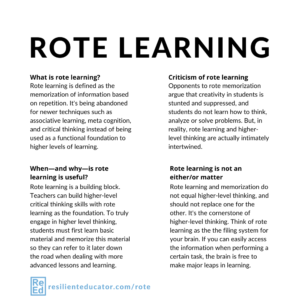
You may also like to read
- Effective Teaching Strategies for Special Education
- 5 Effective Strategies for English Teachers
- 3 Examples of Effective Classroom Management
- Effective Teaching Strategies for Adolescent Literacy Teachers
- Building Effective Student-Teacher Relationships
- Daniel Goleman's Emotional Intelligence Theory Explained
Categorized as: Tips for Teachers and Classroom Resources
Tagged as: Assessment Tools , Pros and Cons
- Certificates in Special Education
- Master's in Education Technology & Learning D...
- Online & Campus Bachelor's in Secondary Educa...
- Our Mission
When Rote Learning Makes Sense
As a youth, I remember feeling cheated out of rich content in my education when I listened to my mother in times of sorrow or tenderness, lovingly recite entire poems and passages from books she studied in high school.
We all know that practice makes perfect, but for some reason perfection is not one of the goals of learning in most schools. In today's classrooms, students practice plenty, but are not required to retain knowledge perfectly.
Somewhere along the way, rote learning got a bad rap. Memorization (there, I said the M word) became anathema to learning. How this came to be, I am uncertain, but what I am certain is that this shift away from memorization has undermined the effectiveness of the teaching and learning process altering whole generations. Perhaps the misplaced angst against memorization has come from the notion that memorization is reserved for teachers as a teaching methodology.
The true nature of memorization, however, is not for the teachers at all, really. It is for the students. And it is the responsibility of teachers to teach students how to use it to help them in their educational career.
The total emphasis on critical thinking has it all wrong: Before students can think critically, they need to have something to think about in their brains. It is true that knowledge without comprehension is of little use, but comprehension requires knowledge and it takes time and effort to acquire.
Bloom's Taxonomy maintains that the highest order of thinking occurs at the evaluating and creating levels which infer that the thinkers must have knowledge, facts, data, or information in their brains to combine into something new, or with which to judge relative importance or value. Therefore, effective knowledge acquisition has to come first.
The Cognitive 411
Students deserve to know how to learn and teachers do them a disservice when they do not teach them useful learning skills. Here are some underlying concepts that need to be accepted before we can continue:
- The brain is a learning tool. This might seem obvious, but the brain is not a passive sponge. It requires active effort to retain information in short-term memory and even more effort to get it into long-term memory.
- Learners need to know that the longer an idea can be kept in short-term memory, the more chance it can be pushed into long-term memory. This is where practice makes perfect makes sense.
- The body is another learning tool -- another often-ignored concept. The body is connected to the brain and if you engage the body, you are engaging the brain too.
- Learners feel an addictive sense of accomplishment when something has been memorized completely.
Memory Games
With these concepts in mind, I would like to discuss some of the memorization learning methods that make it effective and enjoyable:
Learning Aloud
Just as we use our mouths to repeat a phone number over and over to retain it in short term memory, other things can be learned in the same way. One key point here to remember is that the cycle of repetition must be short and quick and no less than three times.
Another point is that if students cannot pronounce a word, there is no way they can remember it. When reviewing flash cards orally, for example, students need to do it quickly, pausing only a second or two for recall.
If it doesn't come, then they need to look at the answer and repeat it aloud, then go on. If done quickly, by the third or fourth iteration, most students can have 100 percent accuracy. The danger is when a student gets stuck on one card for too long, all of the other information in short term memory is lost, making the study ineffective.
One way to help students learn how to do this is to do the flash cards with them, modeling the speed and what happens if the student can't remember: let them look at the answer, but making sure that that student gets a chance to respond correctly again. If the students are in a line (or even better, several lines), the first student answers a card, and then goes back to the end of the line while the rest of the students in the line give their responses to the cards one by one.
Using Rhythm and Breath
Learning text is done at similar speeds, but since the order of learning the words is important there are some effective ways to chain them together. Learn the passage in breath groups, or what can be comfortably stated in one breath. Students using their mouths, because it is part of the body and a learning tool, repeat the breath group until it is firmly in short-term memory, then go on to the next breath group and do the same. When that is done, put both groups together and repeat them.
This is best taught to students using choral repetition. The key here is to be enthusiastic and energetic, praising the students as they practice. Printing the first letter of each word in the breath group can help students remember the words as they learn them.
Jigsaw Strategies
A creative teacher can have groups of students learn different parts of the passage and then switch parts, or stand up as they say their passage, or even move to a different part of the room with each phrase. Since the body is connected to the brain, it is effective to have students do a hand signal or body movement to symbolize the content of the breath group as they say it.
Sometimes it is helpful to start at the end and add phrases in reverse order known as reverse chaining. I have seen seventh graders use this method to learn the complex logical operations and high school students learning chemistry through a chemical reactions dance.
As a Spanish teacher, I found it effective to have the students perform the action of the words they were trying to learn as they told a story, know as Total Physical Response Storytelling (TPRS) . It was exciting to see students enjoying themselves while acting out and stating from memory the words to Caperucita Roja ("Little Red Riding Hood").
Memorization is not a bad thing. Students have to memorize the alphabet, sight words, vocabulary, times tables, and many other things and have fun doing it.
There's countless ways to help students learn how to memorize quickly, efficiently, and enjoyably. You can use music, song, dance, rhythms, patterns, competitions, and games. Once they know how to learn, or memorize, then students can acquire knowledge about anything they want to learn, which is in direction opposition to what critics say about rote memorization.
What are your thoughts on this post? Please share your own stories about learning through memorization.
- Companies & Schools
Memorization is a component of critical thinking, not its opposite
by Erica L. Meltzer | Nov 8, 2013 | Blog , Issues in Education | 0 comments
Education is in the news a lot these days. With the increasing reliance on standardized testing at all grade levels and the implementation of Common Core standards, there’s suddenly a lot of concern about where American schools are headed; and as someone with a significant interest in educational issues, I pay a lot of attention to what people are saying. Reading through education articles and the accompanying comments, many of which bemoan the lack of I’m struck by the extent to which ideas about education have become polarized: on one side, joyless, dry, rote learning, devoid of imagination or interest, with no other end than the thoughtless regurgitation of facts; on the other side, a sort of kumbaya, free-to-be-you-and-me utopia, where learning is always an imaginative and exciting process with no wrong answers or unpleasantness.
To be fair, a lot of the idealizing that goes on is understandable backlash against the rise of standardized tests to judge, well, just about everything. If education has been reduced to learning how to fill in little bubbles on a scantron sheet, it’s natural to want to run screaming as far as possible in the other direction from that sort of drudgery and to make learning fun. To be clear: although I obviously have a stake in the world of standardized tests and believe that well-constructed exams (like the SAT) are useful when used thoughtfully and sparingly, I’m as disturbed as most other people about their sudden ubiquity.
Real education is most certainly not about learning to fill in little bubbles, and at its best, it can be wonderful and stimulating and engaging. But can be wonderful and stimulating is not the same thing as must never be boring or involve any sort of protracted struggle, and there seems to be a camp that conflates the two. Some things are hard; that’s called life. As someone who spends a lot of time teaching students fundamentals that they haven’t acquired in school, I find just as disturbing — and, frankly, bizarre — the idea that those “boring” fundamentals can simply be bypassed in favor of “higher level critical thinking skills.” Yet that idea seems to be have taken root rather tenaciously.
I’d like to suggest that the problem of rote learning vs. critical thinking is actually a false dichotomy. Or rather, there are two types of rote learning, and it’s necessary to distinguish between them: on one hand, there’s the type of rote learning that exists as an end in itself. The point of this type of education is simply to be able to spit back names and dates and facts without any understanding of how they connect or what their larger significance in the world might be. When Americans rail against rote learning, this is what they tend to be thinking of.
On the other hand, there is also a type of education that views rote learning as a means to an end — one that recognizes that factual knowledge is actually the basis for higher level thinking. This type of rote knowledge is also known as “inflexible knowledge.” Cognitive scientist Daniel Willingham has written extensively about the problem with treating critical thinking as something that can be taught in the abstract.
As Willingham says :
People who have sought to teach critical thinking have assumed that it is a skill, like riding a bicycle, and that, like other skills, once you learn it, you can apply it in any situation. Research from cognitive science shows that thinking is not that sort of skill. The processes of thinking are intertwined with the content of thought (that is, domain knowledge). Thus, if you remind a student to “look at an issue from multiple perspectives” often enough, he will learn that he ought to do so, but if he doesn’t know much about an issue, he can’t think about it from multiple perspectives. You can teach students maxims about how they ought to think, but without background knowledge and practice, they probably will not be able to implement the advice they memorize. Just as it makes no sense to try to teach factual content without giving students opportunities to practice using it, it also makes no sense to try to teach critical thinking devoid of factual content.
Willingham’s research flies in the face of much of the educational status quo. One belief currently rampant is that students no longer need to memorize factual information because technology has made that information available to them at the click of a button. Because they no longer have to “waste” brainpower memorizing, or so the line of thinking goes, their minds will be freed up for “higher level critical thinking.” The problem with this view is that it overlooks the fact that critical thinking emerges from the scaffolding provided by rote knowledge; it can’t be divorced from it. When you know facts and dates and concepts by heart, it becomes much easier to see the relationships between them. It doesn’t mean that you’ll automatically see the relationships between them (that’s the point of education), but you will have a stronger basis for doing so.
Put otherwise, if you’re writing a history paper about and have to stop every five seconds and look something up on Wikipedia , your mind will be so consumed with simply trying to process the literal information that you’ll have nothing left over to actually analyze it in any meaningful way. If, on the other hand, you already know the key facts and chronologies and players, you’ll find it much easier to actually say something about why they developed the way they did.
It’s easy to spout off about the beauty of knowledge and potential of technology, but anyone who has ever watched a sixteen year-old stare glassy-eyed at a computer screen with ten different tabs up, then pull up yet another page and google a term repeatedly, pausing only to glance at the first couple of hits before typing in a slightly different version and beginning the whole process again, might start to wonder if educators don’t maybe have things a little bit backwards.
Looking up a couple of pieces of minutiae is one thing, and the Internet is an invaluable tool for someone who needs to do only that, but having to google virtually every basic fact leaves no mental room to do anything with those facts.
Perhaps I’m overlooking something, but it always struck me a somewhat obvious that you don’t acquire higher-level skills without mastering lower-level skills first. If you skip over the fundamentals, you might stagger along looking like you know what you’re doing for a while, but sooner or later, you’re going to crash.
I don’t think most Americans would argue with that idea when it comes to, say, sports or music. They would consider it basic common sense that top athletes don’t simply jump into a high level of competition after a little bit of haphazard training. If they’re not ready, they’ll get injured badly. Likewise, a musician who hasn’t mastered basic scales isn’t usually encourage to schedule her solo debut. It’s understood that years of practice and repetition are required, some of which is “fun” and much of which is not, and that fundamental skills must be mastered before more advanced ones are introduced.
Yet that is more or less the equivalent of what an awful lot of people seem to expect high school student to be able to accomplish academically. Not only is it unrealistic to ask high school students to write papers showing evidence of complex, critical, “high-level” thinking without giving them the grammatical, rhetorical, analytical, literary, historical, and cultural knowledge (among other things) to actually perform that kind of analysis, but it’s downright delusional.
As someone who’s watched lots and lots of sixteen year-olds torture themselves trying to complete college-level assignments when they haven’t yet fully mastered things like transitions or topic sentences or how to analyze quotations, I think I’ve earned the right to say that there’s something very wrong with a system that refuses to explicitly teach skills for fear of destroying students’ creativity, then pushes them to the brink of a nervous breakdown by demanding that they complete work far beyond what their skills allow.
Listening to ed-school grads rhapsodize about the joys of learning, you have to wonder whether they’ve actually ever seen students at home, sobbing hysterically and making their parents nuts as they try to eek out a couple of semi-coherent paragraphs. My guess would be that they haven’t. (For the record, I drove myself crazy over pretty much every English paper I wrote in high school. When someone finally sat me down and taught me the conventions of the genre — in college — I was astonished that it had been so easy all along, then furious that no one had bothered to explain things that simply before.)
So if teachers aren’t teaching the basics well or in a manner that engages students’ interest, it simply means that those basics need to be taught better — not that they can or should be discarded as irrelevant. A terrible teacher can massacre even the most fascinating subject, and an exceptional teacher can teach the basics clearly and directly in a highly engaging manner. From what I’ve seen, students are incredibly grateful when the latter occurs. They end up with a real sense of accomplishment rather than the feeling that they’re grasping a straws.
I do, by the way, acknowledge that plenty of high schools offer little in the way of a challenge to very bright and motivated students — but that by itself doesn’t mean that the students are actually ready for college level work, simply that the level of the high school curriculum needs to be raised. If students who are high-achieving by the standards of their local environments but who actually still lack basic knowledge are placed in so-called “early college” classes , those classes will never get beyond a certain level, regardless of how catchy their titles are or how esoteric their subject matter is.
Students who are missing basic cultural reference points such as Auschwitz (never mind Hannah Arendt) are not, to put it bluntly, going to be able to discuss totalitarianism at anything approaching a college level. That’s not to say they won’t learn something from such a discussion, but their ability to engage in advanced “critical thinking” is going to be seriously compromised.
Given expert teachers and a well-constructed curriculum, there is a way to make high school-level work both challenging and age-appropriate; the two are not mutually exclusive. The real problem is a serious lack of teachers who are experts in their fields and a system that fails to give the teacher who are experts the necessary support.
Everyone’s looking for a quick fix, and no one wants to put their money where their mouth is — administrators occasionally pay lip service to the importance of bringing in the high-quality teachers but do nothing to make the profession more attractive; instead, they turn around and blame the teachers for everything their students fail to achieve. Then they insist that teachers facilitate high level critical thinking while simultaneously discouraging them from reinforcing the kind of fundamentals that are necessary for critical thinking to occur. It’s positively schizophrenic. And insisting that high school students be assigned work above their heads and then given wildly inflated grades so the grownups can pat themselves on the back is not a real solution.
One math tutor I know estimates that schools should be teaching somewhere around a third of the material they currently attempt to cover, but focusing on mastery rather than superficial knowledge. That seems pretty accurate to me. I think that in all the hysteria over accelerating classes to make sure that American students are internationally competitive, schools (administrators) have lost sight of how much information students can reasonably be asked to digest and what sort of building blocks must be already in place to ensure that they’re capable of digesting it.
The current system produces classes that appear advanced but that students aren’t actually retaining anything from. They memorize for the test and then forget because it’s the only way they can get through school; but since the information never makes it into their long-term memories, they never get to the point where they can combine it with other knowledge and jump to the next level.
Let me give you an example: over the last few years, I’ve tutored a number of AP French students at a highly selective New York City public school. Pre-AP classes aren’t tracked, so there’s no accelerated option in the lower levels. By the time students show up in AP, they’ve studied four or five tenses and learned them relatively well, but they haven’t done a lot of reading, and there’s still an enormous amount of grammar that they haven’t been exposed to.
When they get to AP, a lot of them find themselves in over their heads. They have to master the rest of the major tenses (among other things) in five or six or months, read a lot of authentic French, and write full essays in French, complete with theses and counterarguments. They have to cram so much knowledge in so fast that there’s simply no way they can retain it past each test.
Then, when they’re confronted with a situation that requires them to integrate all their knowledge, they freeze. The material looks vaguely familiar, but they still sit there for five minutes, trying to remember the endings for the conditional. Their class sometimes needs two full periods to complete tests because they simply can’t pull information together quickly enough. Five years ago, that was unheard of, but it’s happening all the time now. And there’s nothing their teacher can do about it because of the way the curriculum is structured. She knows they need more time the learn the information, but if she wants them to cover everything on the AP exam, she has to keep pushing through.
When I tell my students that I spent three years covering the subjunctive in high school, learning a different part each year, they’re floored — and jealous. No one has ever given them three years to learn anything for an AP exam.
Trying to come up with a conclusion to this post, I find myself stuck. I’m not particularly optimistic about the implementation of the Common Core, and I don’t have any pat advice to offer. (Optimism is not my forte. Sorry if you were looking for something uplifting.) My only hope is that at some point people will come to their senses and notice that an excessive emphasis on either free-form, pie-in-the-sky creativity or stultifying, sloppily written standardized testing does not an educational system make. But I’m guessing that things will have to get worse before before there’s even a chance that they’ll get better. As for me, I’ll just keep calling it like I see it.
Submit a Comment Cancel reply
Your email address will not be published. Required fields are marked *
Currently you have JavaScript disabled. In order to post comments, please make sure JavaScript and Cookies are enabled, and reload the page. Click here for instructions on how to enable JavaScript in your browser.
Yes, add me to your mailing list.
Sign up for the Question of the Day
Question of the Day
Complete SAT/ACT Grammar Rules
Complete GMAT Sentence Correction Rules
AP English Comp Terms, Condensed
10 Tips for Acing SAT Reading
Commas With Names and Titles, Simplified
Why You Won’t Go to Harvard on a National Merit Scholarship
Recent Posts
- Why are SAT and ACT English benchmarks so low?
- “However” vs. “though”: similar, but not the same
- Statement regarding the recent website outage
- Digital SAT math timing, Common Core, and the “deep understanding” trap
- “SAT® Vocabulary: A New Approach” for the Digital SAT is now available!
Posts by Category
- ACT English/SAT Writing (36)
- ACT Essay (8)
- ACT Reading (22)
- College Admissions (44)
- College Essays (2)
- English Proficiency Exams (1)
- Financial Aid (2)
- General Tips (35)
- Grammar (SAT & ACT) (27)
- Issues in Education (69)
- Parents (13)
- Phonics (26)
- Questions (1)
- Reading (SAT & ACT) (20)
- Reading Wars (7)
- SAT Critical Reading (Old Test) (52)
- SAT Essay (13)
- SAT Grammar (Old Test) (30)
- SAT Reading (12)
- SAT vs. ACT (5)
- Students (10)
- Test Optional (1)
- The Digital SAT (12)
- The Mental Game (18)
- The New SAT (59)
- The Science of Reading (9)
- Time Management (7)
- Tutor Interviews (9)
- Tutoring (27)
- Tutors (16)
- Uncategorized (10)
- Vocabulary (17)
Favorite Links
Barry Garelick on Common Core Math
Cogito Zero Sum
Hannah Arendt on The Crisis in Education
Critical Thinking: Why is it So Hard to Teach?
A Don’s Life (Mary Beard’s Blog)
Educational Jargon Generator
EduBabble Bingo
English is Not Normal
Everybody is Stupid Except You
The Fluency Factory
Gary Saul Morson on Anna Karenina
How I Rewired My Brain to Become Fluent in Math
Letter Against Learning Styles
Mercedes Schneider’s EduBlog
MIT Admissions Blog
Reflections on Liberal Education
The Revenge of K-12 Education
Seven Myths About Education
Silent StopWatch (for standardized tests)
The Usefulness of Brief Instruction in Reading Comprehension Strategies
What David Coleman Doesn’t Know About Literature
Why a Great Individual is Better than a Good Team
Rote Memorization: Definition and Examples

Rote memorization is the process of learning something through repetition and practice. It involves repeating information over and over again until it becomes firmly embedded in one’s memory.
This type of memorization bypasses any understanding or reasoning, as one needs to remember the facts without necessarily understanding them.
For example, if someone were to learn the periodic table by rote memorization, they would need to remember elements and symbols rather than understand why certain elements have certain properties or why some elements interact with others.
This type of learning is often used to learn new words, formulas, equations, concepts, and other related topics.
Rote memorization can also help strengthen recall skills, enabling you to remember more information quickly and effectively.
Rote Memorization Definition
Rote memorization is a learning process that relies on repeating information repeatedly until it is firmly entrenched in one’s memory.
It involves memorizing facts and data without necessarily understanding or reasoning through the material.
According to Seel (2012),
“…rote memorization is a theoretical term to describe storing of information in long-term memory through sheer repetition” (p. 2889).
This learning method does not involve any understanding or reasoning, as the goal is to remember the facts without understanding them.
For instance, one might use rote memorization to learn a language, mathematics formulas, the periodic table, or new vocabulary words.
Furthermore, rote memorization helps strengthen recall skills, enabling a person to remember more information quickly and effectively (Hoosain, 2017).
Simply, rote memorization is a learning process that relies on repeating information over and over again until it becomes firmly embedded in one’s memory.
Rote Memorization Examples
- Learning new words : Many language learners use rote memorization to learn new vocabulary words. Repeating the same word multiple times becomes ingrained in one’s memory and is easier to recall.
- Memorizing formulas : Math classes often require students to memorize certain equations and formulas. Rote memorization is an effective way of learning these equations as it helps with quick recall when solving problems.
- Memorizing periodic table elements : Science students often have to learn the names of elements and their symbols on the periodic table. Rote memorization can be used to help remember all this information quickly and effectively.
- Reciting poems or verses : A poet or other literary figure may recite a poem or verse by having them read and repeat it multiple times to be thoroughly embedded in their head for recitation purposes.
- Practicing musical pieces : Musicians often use rote memorization when practicing a piece of music, as they need to memorize the notes and rhythms to play the music accurately.
- Memorizing facts about countries : As part of a geography course, students may have to learn facts about different countries – such as population size, capital cities, and currencies – through rote memorization.
- Remembering historical dates : History classes commonly require students to remember key events that occurred during certain periods, which can be learned more quickly and effectively through rote memorization.
- Memorizing facts about presidents : When learning about politics, many classrooms will recite facts about different presidents for them to commit those facts into memory faster than if they were using a different learning technique like reading comprehension skills alone.
- Memorizing medical terminology : Medical students usually have to remember complex medical terminology, which includes diagnosis codes, Latin terms, and treatments, among others. This information must be communicated quickly and accurately so that physicians can diagnose patients. Rote memorization helps with this process, significantly reducing typos due to its repetition-based method of learning the said material.
- Reciting scriptures from religious texts : Religious organizations sometimes require adherents to remember scriptures from holy texts through repetition. Rote memorization can aid with the smoother recollection of such texts when needed at specific occasions or services related to said religion/organization.
Rote Memorization vs. Meaningful Learning
The main difference between these two learning styles is that rote memorization relies on repetition. In contrast, meaningful learning requires understanding complex topics or ideas to recall them effectively.
- Rote memorization is a method of learning that involves repetition and drill-type exercises. It involves repeating something over and over until it is thoroughly learned (Mayer, 2002). An example of this could be the periodic table – a student may need to repeat each element and its symbol multiple times for them to commit it to memory.
- Meaningful learning , conversely, involves synthesizing and making connections between different topics or ideas and comprehending material for it to be remembered (Mayer, 2002). For example, rather than simply repeating the names and symbols of elements on the periodic table, a meaningful learner would also consider their physical properties and reactivity.
Additionally, meaningful learners can apply what they have learned in different contexts due to their deep understanding of the material.
In contrast, rote memorizers typically only remember things in the exact same way they were taught them (Mayer, 2002).
So, rote memorization can be useful for quickly committing certain facts or pieces of information to memory, but meaningful learning is more effective in the long run as it requires a deeper understanding of the material.
Rote Memorization Techniques
While rote memorization is not the most effective way to learn, some techniques – repetition, association, visualization, chunking, and mnemonic devices – can help make it easier.
Here is a brief overview of these techniques:
1. Repetition
It is the most common technique used in rote memorization. It simply involves repeating a piece of information over and over until it is ingrained in one’s memory and can be easily recalled (Seel, 2011).
2. Association
This technique involves associating pieces of information with ones that are already known, thus making them easier to remember when needed (Norman et al., 2002).
For example, associating a person’s name with their face or a term with its definition can help commit both pieces of information to memory faster than without an association.
3. Visualization
This technique involves creating mental images to help remember certain facts or ideas more quickly and accurately (Seel, 2011).
For example, visualizing the names of elements on the periodic table as images rather than just words can help commit that information to memory faster than relying only on repetition alone.
4. Chunking
This technique involves breaking down complex ideas or concepts into smaller chunks that are easier to remember (Xu & Padilla, 2013).
It is especially beneficial for longer strings of facts or knowledge, such as historical events or detailed formulas, which cannot be easily committed to memory through mere repetition alone.
Read our guide on chunking
5. Mnemonic Devices
A mnemonic device is a phrase or acronym used to help associate different pieces of information, making it easier to recall when needed.
For example, ‘My very eager mother just served us nine pancakes’ could aid in remembering all nine planets in order from nearest to furthest from the sun (Mercury, Venus, Earth…).
Read about mnemonic devices including: the peg word system , the memory linking method , and the method of loci
Benefits of Rote Memorization
Rote memorization has some distinct benefits, including quick learning, improved accuracy, and better recall.
Rote memorization is a useful technique for quickly learning information that is necessary to know but does not necessarily require deep understanding (Battino, 1992).
It can be especially helpful in contexts such as learning foreign language vocabulary, memorizing historical facts, or mastering complex formulas or equations.
Additionally, it can be used to help commit factual knowledge to memory, such as names, dates, and places which often require repetition to remember them correctly.
In short-term memory , facts and figures are first stored in a student’s mind. However, the more they revisit this information with repetition, the better their chances of solidifying it within their long-term memory (Battino, 1992).
Furthermore, rote memorization provides some benefits when it comes to problem-solving . It helps create strong mental models and frameworks that can be used to break down complicated issues into more manageable pieces.
Disadvantages of Rote Memorization
The primary disadvantage of rote memorization is that it provides a different level of understanding and insight than more meaningful approaches to learning.
Rote memorization requires simple repetition, often not giving one a deeper understanding of the concepts or ideas being learned.
Additionally, using this technique regularly can lead to mental and physical fatigue due to the monotonous nature of repeating information over and over.
Finally, rote memorization may also be inefficient when it comes to problem-solving, as it does not allow for flexibility in thinking or the ability to think outside the box.
Rote memorization is a learning technique that relies heavily on repetition to commit information to memory.
For example, it can be used to learn foreign language vocabulary quickly, memorize historical dates or equations, and commit factual knowledge such as names and places.
While it can be effective for quickly learning facts, figures, and other information, it does not provide the deeper understanding and critical thinking skills fostered by meaningful learning approaches.
Although rote memorization has clear benefits, such as improved recall and accuracy, its limitations should be considered.
Ultimately, a balanced learning approach combining rote memorization with meaningful learning can lead to a more well-rounded education, helping learners remember information and understand and apply it in various contexts.
Battino, R. (1992). On the importance of rote learning . Journal of Chemical Education , 69 (2), 135. https://doi.org/10.1021/ed069p135
Hoosain, R. (2017). Rote memorization or concept learning . London: Open Dissertation Press.
Mayer, R. E. (2002). Rote versus meaningful learning. Theory into Practice , 41 (4), 226–232. https://doi.org/10.1207/s15430421tip4104_4
Norman, G. R., Der, V., & Newble, D. (2002). International handbook of research in medical education . London: Kluwer Academic.
Seel, N. M. (2012). Encyclopedia of the sciences of learning . New York: Springer.
Xu, X., & Padilla, A. M. (2013). Using meaningful interpretation and chunking to enhance memory: The case of Chinese character learning. Foreign Language Annals , 46 (3), 402–422. https://doi.org/10.1111/flan.12039

Viktoriya Sus (MA)
Viktoriya Sus is an academic writer specializing mainly in economics and business from Ukraine. She holds a Master’s degree in International Business from Lviv National University and has more than 6 years of experience writing for different clients. Viktoriya is passionate about researching the latest trends in economics and business. However, she also loves to explore different topics such as psychology, philosophy, and more.
- Viktoriya Sus (MA) #molongui-disabled-link 15 Free Enterprise Examples
- Viktoriya Sus (MA) #molongui-disabled-link 21 Sunk Costs Examples (The Fallacy Explained)
- Viktoriya Sus (MA) #molongui-disabled-link Price Floor: 15 Examples & Definition
- Viktoriya Sus (MA) #molongui-disabled-link Linguistic Relativity: 10 Examples and Definition

Chris Drew (PhD)
This article was peer-reviewed and edited by Chris Drew (PhD). The review process on Helpful Professor involves having a PhD level expert fact check, edit, and contribute to articles. Reviewers ensure all content reflects expert academic consensus and is backed up with reference to academic studies. Dr. Drew has published over 20 academic articles in scholarly journals. He is the former editor of the Journal of Learning Development in Higher Education and holds a PhD in Education from ACU.
- Chris Drew (PhD) #molongui-disabled-link 25 Positive Punishment Examples
- Chris Drew (PhD) #molongui-disabled-link 25 Dissociation Examples (Psychology)
- Chris Drew (PhD) #molongui-disabled-link 15 Zone of Proximal Development Examples
- Chris Drew (PhD) #molongui-disabled-link Perception Checking: 15 Examples and Definition
Leave a Comment Cancel Reply
Your email address will not be published. Required fields are marked *
Importance of Memorization in Learning
Discover the importance of rote memorization in learning and why it's more crucial than you think. Explore the benefits and strategies with Brainscape today!
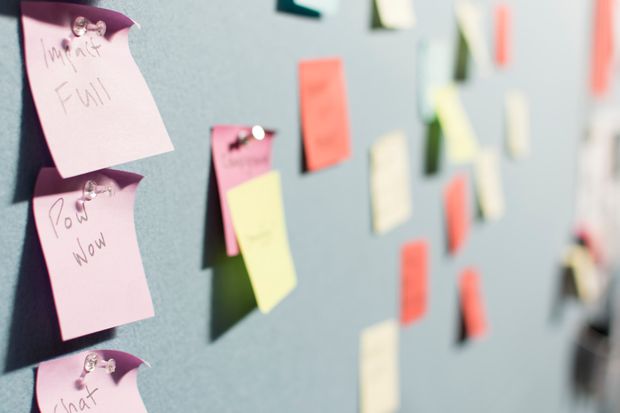
If you're active in the teaching world, you've probably noticed that in the past few years we're not being encouraged to focus on teaching our students to remember facts. You may have actually noticed a strong backlash against drill & practice , in favor of “constructivist” activities and “project-based learning.”
The actual memorizing of facts, many argue, is an outdated educational practice, since anyone could just Google a fact on-demand or look it up on Wikipedia these days. The mantra seems to be that we should focus all school activities on the acquisition of skills as opposed to knowledge.
Well we disagree — and not just because we have made the world's most effective web and mobile “ smart flashcards ” app. Here's our argument for memorization (as part of a wider, varied education):
The value of rote memorization
There are numerous cases in which having knowledge immediately at the tip of your tongue can have tremendous social and professional value.
For example, recently at a networking event, when I casually asked a Nigerian entrepreneur how much of his business was conducted in English versus in his native Yoruba , he immediately became more engaged in our conversation. It was as if the simple fact that I knew that Yoruba was spoken in Nigeria seemed increase my social credibility, and therefore our rapport.
The same goes for professional settings. If I am a pharmaceutical salesman talking to a doctor about a specific digestion drug, and he asks if it has any effect on the process of peristalsis , it will look quite unprofessional if I have to pull out my medical dictionary to look up the word. Those facts need to be ingrained in my brain so I can access them immediately.
It's true that we don't have to remember everything. There's good reasons we give out formulas for physics or math tests—we don't really care if students remember the formula for the area of a circle; we care if they can solve problems using it. You can be a perfectly good coder without remembering every single Python command, you can speak French fluently without remembering every word, and you can even be a pretty good lawyer without remembering every legal case in the history of the world.

But each of those jobs does require you to remember some things. You can't code effectively without remembering most commands, you can't speak French fluently if you have to look up every word, and to be a competent lawyer, you really do need to remember a lot of law.
Memorizing every fact isn't essential for most people's lives; but memorizing at least some facts is. Imagine how effective your teaching would be if you couldn't remember your students' names?
The most important thing is that educators carefully determine where in the curriculum that rote knowledge retention is necessary, and draw the line before such memorization becomes a waste of time.
Rote memorization vs. constructivist learning
Rather than rote memorization, many educational situations need more personalized learning. Of course, most constructivist educators will argue that real-life simulations, on-the-job training, and project-based learning are more effective at learning new concepts than rote memorization.
And it's true: these forms of education can be very effective. They can teach skills like problem-solving and critical thinking, even while teaching facts for students to remember. The problem is that there is no single cost-effective constructivist activity will guarantee that your students (or you) will be exposed to all the concepts you need—or that you will fully remember the facts that you are exposed to. For example:
- Medical residency can teach you a lot about the body, but can't reliably teach full, comprehensive anatomy.
- Articling can teach law students a ton about how being a lawyer works, but isn't designed to teach them all the law .
- Working at a vineyard can teach someone a ton about how wines are grown and made, but can't reliably teach all the concepts needed to become a sommelier .

How to do rote memorization effectively
Like it or not, memorizing facts is essential. And some people need to remember a lot.
Luckily for you, we're a little obsessed with the research around learning and memory. Here's what you need to do if you actually want to acquire a full range of knowledge about a given topic.
- Study deliberately . Deliberate practice is still the best way to master something—including information.
- Use active recall . This means that rather than doing matching, multiple choice, or re-reading exercises, you should instead perform learning activities where you need to actively reach back into your memory to find the information. This can include flashcards or testing yourself.
- Use spaced repetition . You need to space the learning out, but not space it out so far that you forget it.
Brainscape's web and mobile flashcard app is designed using these principles. It's the most effective app out there to quickly learn—and remember—large amounts of information. It offers a personalized learning experience that optimizes student performance. You or your students can use Brainscape in their out-of-class time to remember the facts, leaving you free to do more collaborative and constructivist activities in class.
Learn more about how you can use Brainscape as a learning tool with your students . And check out our huge guide on how you can double the learning effectiveness of your students .
Flashcards for serious learners .

The Common Core’s Focus on Understanding VS Memorization

There has been a definite shift in education as the Common Core State Standards ( CCSS ) asks teachers, parents, and most importantly, students, to focus more on understanding, or critical thinking. This may be one of the most challenging hurdles for many students to overcome as they make the transition from the old standards of learning. With the old standards, rote memorization, or memorization and repetition of facts, figures, tables, and such, in order to recall topics was a common method for learning. Now, however, teachers must use active learning techniques, such as role-playing, peer teaching, debate, and group projects, in teaching their students, which help with meaning and understanding.

UNDERSTANDING VS MEMORIZATION
Memorization is the skill of consciously trying to remember facts and information. It can be used for a variety of information, but it is not useful in all situations for young learners. For example, students who learn basic addition facts by memorization may be limited by the number of facts they can retain. With understanding, a student is asked not to reproduce facts and knowledge. But to form relationships between those facts and knowledge, to explain those relationships, and to analyze. For example, a student who has learned basic addition facts will be able to see patterns.
Key Shifts in Learning
Some of the CCSS’s key points include major shifts from the previous standards. These shifts will help students gain greater or deeper understanding of the topics they see each year. Along with opportunities to think outside of the box, students will:
- Have a better focus on a smaller number of topics because fewer topics means they will be able delve into topics, rather than to just touch the surface.
Students will no longer see a repetition of topics from year to year, but rather a better scaffold of topics from year to year that will introduce greater complexity and profundity. For example, in 3rd grade, the CCSS calls for students to learn measurements in time, liquid volume, and mass; however, in 4th grade, students focus on relative sizes in measurements and the use of the four operations to solve word problems with time, liquid volume, mass, money, and distance. This scaffolding ensures that not only will students continue to use the knowledge of the previous year, but will build on that knowledge with precision and deeper understanding.
- Instead of learning topics at earlier and earlier grades, students will work on understanding topics, not from rote memorization, but from true understanding of the concept, as well as applying that knowledge to different situations.
This model of learning, as described by the CCSS , requires students to understanding of concepts rather than the ability to memorize procedure. For example, although students could memorize “tricks” for solving math problems, in order to be more successful, students will need to prove understanding of concepts by applying the topic to new situations and practicing with understanding.
- Because students must be knowledgeable of a variety of topics, they will need to read widely and thoroughly, including outside the bounds of their interests.
Many students will find that the variety in their reading will expand as they are exposed to more informational texts, or more fictional texts. In order to prove understanding of comprehension, students will need to show, write, and speak about evidence from the texts from which they have read.
Uses for Memorization
This is not to say that rote memorization does not have its place in education. After all, according to Bloom’s Taxonomy , the system by which human thinking, learning, and understanding is classified, students must have facts and data in order to evaluate or infer about other information. Some information which students often memorize includes:
- Sight Words
- Times Tables
- Counting Numbers
- Chemistry Tables
- Basic Formulas
This means that even with the shifts in learning and a focus on understanding with the CCSS, rote memorization is important. As students develop knowledge of basic facts, data, and information, they use these details to provide supporting details to evidence based questions. In a simpler context, rote memorization can be the basis of a basic social life for both the young and the old, so students should not neglect the skill. For example, the ability to memorize the names, birth dates, and other details about a friend goes hand-in-hand with being a good friend, a fundamental part of society. Alternatively, using mnemonic devices, or memorization tricks, to memorize important dates, capitals and states, or other geographic features may help students successfully and quickly pass quizzes or tests.
While the CCSS has definitely leaned towards understanding and critical thinking, there are still places in the guidelines where memorization has a place. Memorization is, of course, not the catch-all of education and learning, but it can be handy tool for simple and unadorned lists. For complex theories, methods, and concepts, students should and will delve deep into the subject and be rewarded for their diligence.
Author: Nicole Acevedo, Teacher Manager at MathWizard, Inc.
Leave a Reply Cancel reply
Your email address will not be published. Required fields are marked *
Save my name, email, and website in this browser for the next time I comment.
- College Applications
- Hands-on Activities
- Infographics
- Find your nearest academy
- Privacy Policy
- Terms & Conditions
©2021 A Grade Ahead, Inc. All Rights Reserved.
Find your local academy
You are not eligible for the enrichment at home program., but there is good news.
You are close to A Grade Ahead of Powell Enrichment Academy.
Call today to schedule an assessment, or stop in to see how our small classes and educated teachers can help your student reach his or her goals. 10202 Sawmill Parkway Powell, Ohio 43017, USA 614.790.1111
- Philosophy & Methodology
- Academic Writing
- Creative Writing
- Public Speaking
- Adult English Programs
- TOEFL Test Preparation
- TOEFL Diagnostic Testing
- Summer Programs
- International
- Testimonials
Home → ABOUT → Philosophy & Methodology
OUR PHILOSOPHY & METHODOLOGY
- Memorization vs Critical Thinking
- Methodology
- The Language Transit Difference
Language Transit believes that true learning and intelligence comes when children are able to think critically, understand concepts, and figure out new problems on their own. While there are some very positive aspects of memorization, we feel that this type of learning should only be used as a tool and is not a good foundation for a teaching methodology. Rote learning can be a good way for a child to learn their times tables or memorize certain facts for a test and can often bring about quick results. Memorization, or commonly called cramming or the “drill and fill” method of learning, is a good way to expose young, beginning learners to vast amounts of basic information necessary as building blocks for education. This is how we learn the alphabet. It is also great for test takers and is one of many academic tools we may implement in our test preparation programs. There is the old adage, “practice makes perfect,” and this is often the thought behind rote learning. However, once a child is beyond kindergarten or early grade school, what does it mean to truly educate a child?
At some point, we all question what is more important for our children, grades or true learning. We definitely want your child to excel academically but what makes a great leader, thinker, world changer, innovator, or even just a well adjusted individual? What worked or is working for you may not be what works for our children. The world is changing rapidly and no one knows what the future will look like. The important question we may want to ask ourselves as parents is what life skills, in addition to academics can we give our children to help them navigate an uncertain, yet exciting future.
The mind is not a vessel to be filled, but a fire to be kindled. -Plutarch
Do not train a child to learn by force or harshness; but direct them to it by what amuses their minds, so that you may be better able to discover with accuracy the peculiar bent of the genius of each. -Plato
Back to Top
- SUMMER PROGRAMS
- INTERNATIONAL
- TESTIMONIALS
Research to Policy
Want to Teach Critical Thinking? Forget Rote Learning
Gone are the days when school was only about “the three R’s”- reading, writing, and ‘rithmetic. Critical thinking is now a central educational goal, from the Common Core State Standards to employers’ demands for the future workforce. But students are apparently falling short of that goal.
According to a test viewed as the “Nation’s Report Card,” a third of America’s fourth graders fail to comprehend what they read or are unable to provide supporting evidence for their interpretation. A similar percentage struggle to draw conclusions from text. By 12th grade, a quarter of students are still lacking these basic comprehension skills. The problems may become most obvious after high school. How can a person develop the next great innovation if she doesn’t understand how existing technology works? How can a journalist or a lawyer ferret out corruption if he doesn’t know how to read between the lines?
The problem is that many educators and policymakers don’t understand how to help students understand, write researchers Karen Murphy, Carla Firetto, Liwei Wei, Mengyi Li, and Rachel Croninger. Developing critical thinking is more complicated than teaching basic arithmetic, and yet teachers receive little training in how to do it. In fact, much of American education is based on the mistaken belief that adults simply need to give knowledge to students who receive it, in the form of facts and information, say Murphy and colleagues. Students get more information at earlier ages than ever before, and are frequently tested to see if they have retained it. But neither strategy teaches them how to think and make connections.
The key to developing critical thinking in the classroom is small group discussion, suggests research reviewed by Murphy and her collaborators. Engaging in dialogue with teachers and a few classmates encourages students, even young ones, to be curious, consider different perspectives, and make connections with one’s life experiences and existing knowledge. There seems to be something about the intimacy or opportunity of small groups that makes them more worthwhile than whole-class discussions.
But not all small group discussions are effective. Simply asking a group of students to share their reaction to a text isn’t going to ensure they get it or learn anything from it. (Who doesn’t remember listening to a classmate tell a long personal story that made the text less interesting and maybe even less clear?) Teachers need to be thoughtful about what they do before, during, and after class discussions.
It is helpful if teachers “prime” their students to understand a text before they read it, for example by having an initial discussion about students’ lives or cultural experiences that connects to the text. That can help students make immediate connections between what they are reading and their existing knowledge, which makes it easier to both understand and remember information. Teachers can also prime students after reading but before discussion, for example by talking about how the text is structured or by asking them to generate their own questions. But, the researchers caution, students might need a lesson in crafting thoughtful questions, because, “Unfortunately, many students are wise in the ways of schooling and are more familiar with traditional forms of question and answering—questions that require low-level recall and basic comprehension of the text.”
Teachers then need to do a good job moderating the discussion, asking students to clarify their thinking and provide evidence for their ideas. Over time, they should hand over more and more control to students so that they are decreasing their own talk and encouraging students to increase theirs. (Many teachers aren’t well-versed in that strategy, as students can attest.) When a teacher starts to see students elaborating on each other’s thinking, that’s a sign that they are thinking critically.
Another piece that is sometimes overlooked is post-discussion debrief. When teachers give immediate feedback about the conversation process, it helps the whole class during the next discussion. And when the class sets goals for future discussions, it helps them reflect on what they’ve learned and encourages them to transfer it to other contexts. “Preparing students to think intensively and to make evidence-based, incisive decisions is a daunting, but not impossible, goal,” Murphy and colleagues write. The key, they counsel, is to spend less time on rote learning of information and “refocus” on what really makes students think.
Access the article, by Murphy, et al,”What REALLY Works: Optimizing Classroom Discussions to Promote Comprehension and Critical-Analytic Thinking” from Policy Insights from the Behavioral and Brain Sciences .
Teachers’ Beliefs Affect Whether Students Meet Learning Standards
January 3, 2017
Do Video Games Improve Learning?
January 10, 2017
Recent articles
NBES Meets, Welcoming New Acting Director
SBS Subcommittee of the NSTC Updates NIH Community
OMB Revises Standards of Race and Ethnicity Data
Science and Engineering Report Released
FABBS News Highlights
Federal budget and policy updates plus news from the community — the FABBS newsletter, twice a month in your inbox!
1200 New York Ave. NW Suite 459 Washington, D.C. 20005
© Federation of Associations in Behavioral & Brain Sciences FABBS Privacy Policy | This site is protected by reCAPTCHA and the Google Privacy Policy and Terms of Service apply.
You are using an outdated browser. Please upgrade your browser to improve your experience.
- Online Math Tutor
Rote Learning vs. Critical Thinking: How an Online Math Tutor Can Help
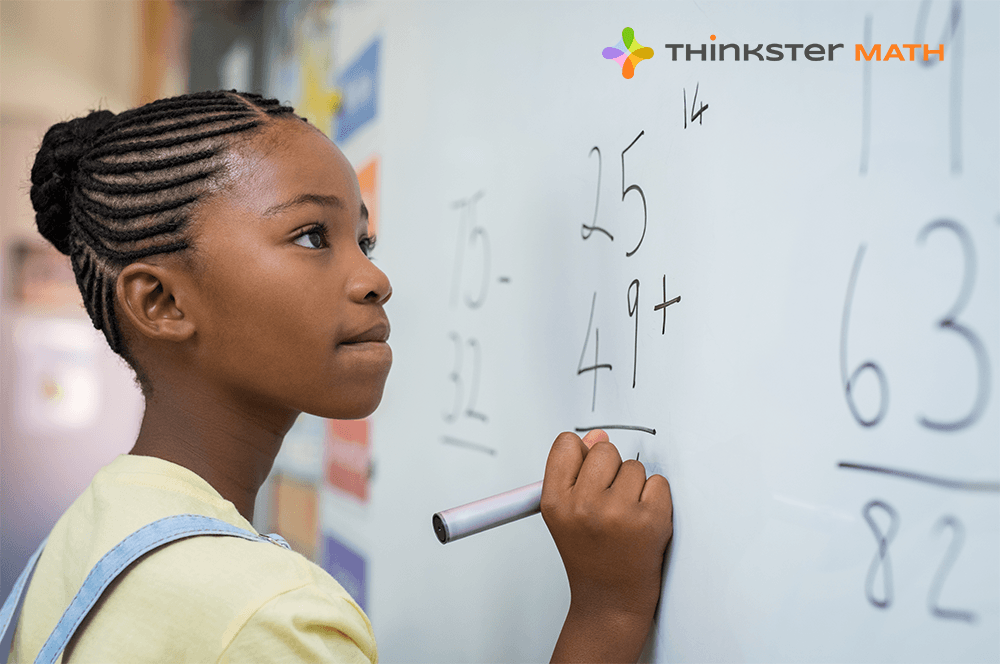
Last Updated on May 31, 2022 by Thinkster
Do you remember memorizing multiplication and division tables in school? If you memorized things like how to spell certain words and the capitals of the 50 states, you’re not alone. While memorization has its place in learning, current education standards have changed to move students beyond basic rote learning and into meaningful learning practices and critical thinking, which are more beneficial in the long run.
So, what does this mean for your student? If you’re worried about your child falling behind, or are having trouble mastering critical thinking skills, working with an online math tutor might be necessary. The right tutor can help take your student beyond rote learning, so they’ll better understand how to succeed throughout school and beyond. What’s the Difference Between Rote Learning and Meaningful Learning?
What’s the Difference Between Rote Learning and Meaningful Learning?
Rote learning is essentially memorization that is based on repetition. The thought behind it is that the more one repeats information, the quicker that person will be able to recall the information when needed.
Meaningful learning (or deep learning ), on the other hand, focuses more on engaging with the subject matter, thinking critically, and understanding how all the pieces work together. In its essence, it encourages understanding rather than memorization.
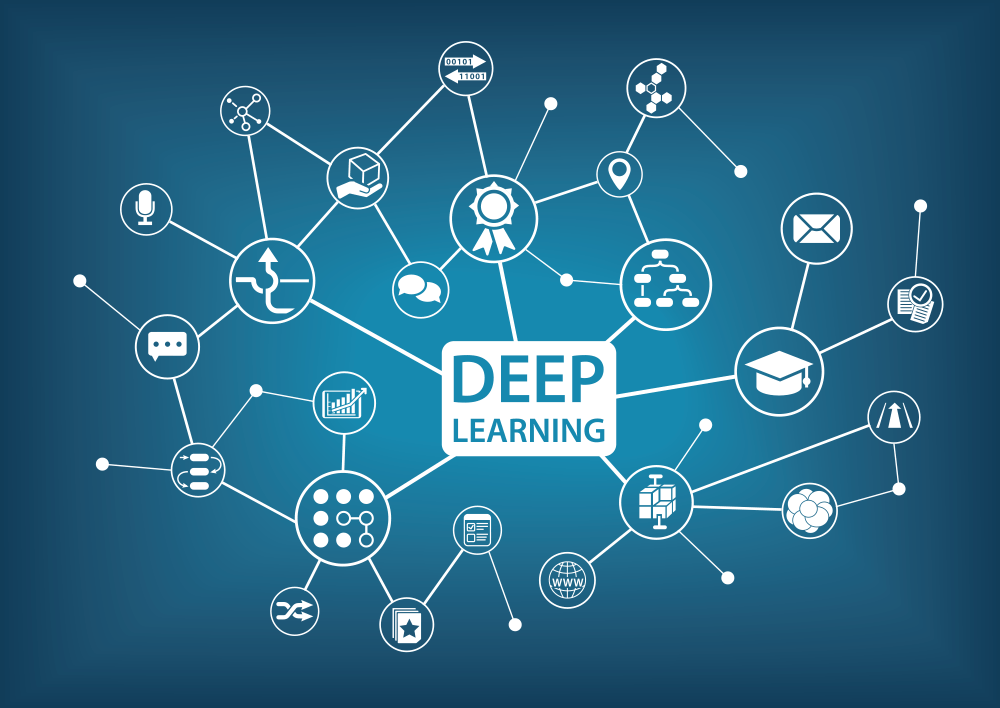
But why is this so? According to cognitive scientists, each time the brain is given new information, it has to make a decision: is this information relevant and worth remembering? If so, it will make the effort to store the information in its long-term memory. If not, the likelihood of being able to efficiently “transfer” the knowledge is much lower.
Unfortunately, in most schools, the lessons end before students can reach this level of deep learning. Surface learning may lead to a passing test and getting a good score but doesn’t lead to long-term success. If you notice this happening to your child, it may be time to work with a private, online tutor who can build this foundation of learning.
The Importance and Benefits of Meaningful Learning
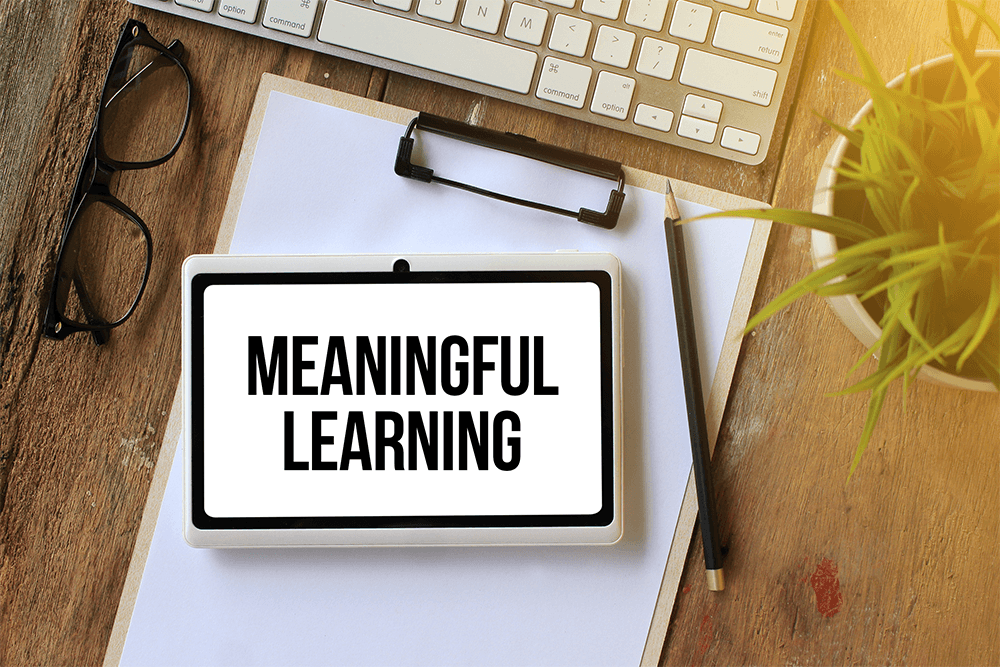
Critical thinking and meaningful learning provide students with the keys to success, and it often compounds on itself. Especially when it comes to math worksheets and curriculum, the concepts your child is learning build on each other. So of course, if your child deeply understands the basics of one concept, it will be easier for them to keep up as the lessons get tougher.
We’ve discussed how math skills help your child in other areas , overall, and critical thinking is an important part of that.
Meaningful learning helps students become successful by allowing them to focus on learning outcomes and how they are able to connect new information to prior knowledge that they have already gained. It also helps a student to pontificate and think about what they are learning, and thus create anchors in their mind to new information that is being processed.
This kind of anchoring helps them develop a deep connection to the material they are learning and makes them cognitively and emotionally involved in the process. This overall approach helps students become really good very quickly in the new subject matter they are trying to learn.
So whether they are learning the Pythagorean theorem for the first time or trying to understand how to solve an algebraic math problem on their math homework , your child will quickly realize the significant long-term success they will achieve with meaningful learning approaches.
It can help your child in many other areas, too:
Critical Thinking Will Help Your Child in Their Future Career
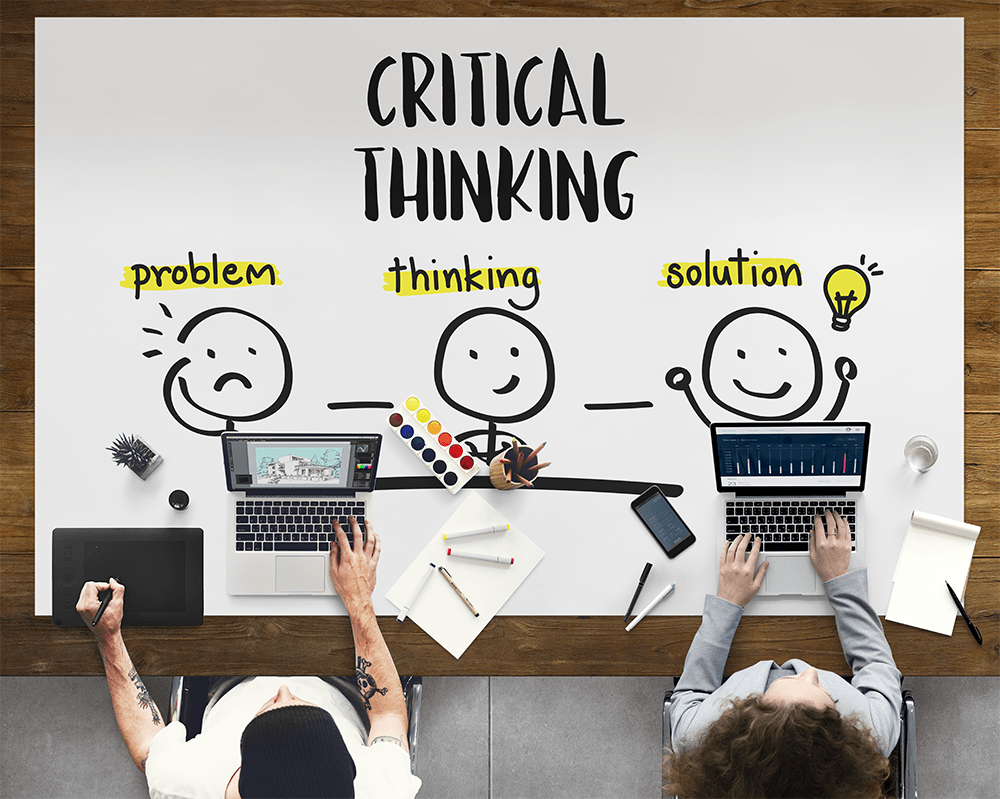
Critical thinking skills are important to success, not only in math but in life. According to a 2015 report by the Foundation for Young Australians , in the three years before that, the proportion of jobs listed that require possessing critical thinking skills has increased by 158 percent. In conjunction with this, in 2006, a report by a consortium of more than 400 United States employers listed “critical thinking” as the most desirable skill in new employees. According to Pearson Publications , employers indicated that it’s an important skill that is critically needed across all fields, including management, finance, marketing, and more, as it makes employees have the following:
- Good analysis and problem-solving skills
- Good judgment and decision making
- Good overall job performance
- The ability to evaluate the quality of information presented
- Job-related knowledge
- The potential to move up within the organization and get promoted
Meaningful Learning Often Boosts Motivation
Many students get bored with basic memorization and put out little effort because they can’t see the value in it. But when they begin to understand the what and why behind a certain concept, it can motivate them to learn more.
In a 2013 study of 30 high schools, researchers found that 70 percent of high-school students report they are bored at school every day. But in classrooms that focused on deeper learning — incorporating elements like identity, mastery, and creativity — students actually enjoyed going to school.
In these classrooms, teachers ask questions without giving students the answers right away. As they grapple with uncertainty and failure, the students must create their own knowledge instead of simply receiving it.
The result? Engaged, motivated students who want to learn more and do more.
Is Rote Memorization Really That Bad?
In most cases, school tests and exams are set up to reward students who simply memorize the information. Once you’ve earned a passing grade, there’s no need for your brain to remember the information — so out it goes!
Unfortunately, things change when they take tests like the SAT and ACT , or when they need to approach a complex problem in real life. Suddenly, they’re faced with a new situation that they didn’t previously memorize, and they don’t have the skills to find the answer.
While a good memory comes in handy for many things (like remembering passwords and birthdays!), mathematics is one area where you truly need deep learning.
The Thinkster Difference
According to a study done in 2014 by the American Institutes for Research (AIR), which was later updated in 2016, students that attended a deeper learning network school had a higher graduation rate by 8 percent than students in other high schools. The students studied in 2014 were also 3 percent more likely to enroll in a postsecondary institution and had higher standardized test scores in both math and English.
But if you don’t have the resources or access to a school like this, there are ways you can support your student. If your child is memorizing information instead of thinking critically about it, it may be time to work with an online math tutor outside of the classroom.
The Thinkster Math Tutoring philosophy fits in directly with the concepts of meaningful and deep learning to help your student understand what they are learning and be able to then transfer that knowledge to other scenarios.
We want our students to become lifelong learners, so we use real-life situations in math lessons and worksheets. And, our unique approach to learning allows students to absorb and process the information, interact with the problem, and finally, be able to think through the problem until they’ve figured out how to answer it.
Moreover, the Thinkster online math tutor program goes beyond math skills to help students become logical thinkers while also boosting confidence. We want our students to understand the why behind the strategies they use to solve a math problem. Learning information in these non-routine ways makes their mind more powerful and efficient.
Rote learning, which is often the focus of traditional teaching methods, leaves students more vulnerable to just following steps and rules to answer questions. Instead, we work with your student to get them to think through the problems – which leads to them being able to problem solve in a variety of contexts.
Our technology-enabled tutoring program uses Active Replay Technology (ART) that actually tracks how your student arrives at an answer. This helps to identify where students make mistakes and provide added guidance so students can then take this knowledge and solve new problems. This helps improve their understanding of math.
At Thinkster , we see math as more than just numbers. We see it as a language. Learning a foreign language is easier if you can relate the grammar and vocabulary to a specific context and then apply those roles to other contexts – that’s how we teach math. Nuances help students develop confidence and become fluent in the language of math.

Our program is dedicated to teaching not just math skills but also thinking skills. Our curriculum is designed to use real-life situations that help students think non-linearly, creatively, and analytically. Being able to sort through the relevant information and solve problems is the true mark of mastery, and how you know you’ve gone beyond rote learning to critical thinking.
Try Thinkster For Free
Ready to try something new? Thinkster provides all of this through its customizable math system, helping your child master critical thinking skills .
Our plans start out at basic levels with unlimited math worksheets and daily grading, or you can get the math worksheets along with four sessions with an online math tutor , as well as math homework help and test prep .
Our online math tutors are experienced math teachers that work with students during interactive whiteboard tutoring sessions. They also provide daily feedback on your student ‘s work at no extra cost.
The real-world examples we use and the integrated system take your student beyond rote learning to prepare them for harder math concepts down the road.
So what are you waiting for? If you’re looking for online math tutoring to help your child, you can try Thinkster risk-free .
Thinkster provides a full-fledged online tutoring platform (driven by AI, behavioral, and data science), as well as supplemental math worksheets , math homework help , test prep , and more. Our Parent Insights App allows you to monitor your student ‘s work and learning improvements at any time.
An elite, expert math tutor and online teaching system work together to help your student go beyond just learning math – we want them to master it.
Learn more about our curriculum and teaching style here .
Subscribe to Thinkster Blog

Recommended Articles

How to Tell If Your Math Tutor App Is Worth the Cost

- Why Thinkster Math?
Why Homeschooling Parents Choose Thinkster for Math Problems and Curriculum

- Math Tutoring
Why Hiring a Math Tutor Is Like Buying Fast Food

IMAGES
VIDEO
COMMENTS
Rote Learning Vs Critical Thinking. Learning is defined as the acquisition of knowledge or skills. Knowledge and skills are acquired in various ways: Through practice and experience such as riding a bike. Through study, reading what others have written about the subject. Through instruction, being taught by someone with the desired knowledge.
Rote memorization vs critical thinking (difference between memory and intelligence) Learning strategies often generate significant curiosity. Among these, the merits and demerits of rote memorization are frequently debated. Recently, with standardized tests becoming a predominant measure of a student's academic success, rote memorization, which ...
Says Chan, "rote memorization involves repeating and memorizing information without a deep understanding of its meaning, often leading to short-term retention and limited application." On the other hand, he explains that "meaningful learning focuses on understanding the underlying concepts and principles, encouraging critical thinking, and ...
Brain development affects the foundations of learning. Rote learning can be an important tool in building a foundation for higher-level critical thinking skills. However in students who struggle academically with conditions like ADHD and learning disabilities, this approach can be challenging. Poor working memory is common in children with ADHD ...
Rote Learning Vs Critical Thinking. In the landscape of secondary education, a balance between rote memorization and critical thinking is essential for meaningful learning. Teachers often navigate this terrain, recognizing that while active learning strategies engage students in higher-order thinking, foundational knowledge—sometimes built ...
Though rote learning has a few benefits, critical thinking is beyond a doubt, the most instrumental tool for the development and successful integration of an individual in society. The key to success is a harmonious balance between the two, resorting to rote learning only in cases of essential memorization while reaping the unlimited potential ...
Rote memorization does not promote critical thinking. Critical thinking skills could fall by the wayside if rote learning becomes your primary teaching method. Many educators agree there is a place for rote memorization in the school system. However, most teachers have opted for other methods geared toward improving students' long-term memory ...
3) Memory can help students get to grade level. Kids who grow up in poverty (51 percent of those in public schools) underperform in five critical areas. Language is first, and the next two are ...
While rote learning is more about repeating to memorize details, which is something you could do without really processing what you are memorizing, critical thinking involves lots of active thought. Both rote learning and critical thinking help your brain develop different essential abilities. Rote learning helps your brain improve its ability ...
Memorizing versus Understanding. In this post Yana reviews an article that advocates for a hybrid approach to memory and understanding - "development of understanding takes place alongside or in conjunction with intentional encoding and strengthening of information in memory. Which Should Come First: Problem Solving or Instruction.
The Editorial Team November 6, 2012. Article continues here. Rote learning is defined as the memorization of information based on repetition. The two best examples of rote learning are the alphabet and numbers. Slightly more complicated examples include multiplication tables and spelling words. At the high-school level, scientific elements and ...
Learners need to know that the longer an idea can be kept in short-term memory, the more chance it can be pushed into long-term memory. This is where practice makes perfect makes sense. The body is another learning tool -- another often-ignored concept. The body is connected to the brain and if you engage the body, you are engaging the brain too.
term memory. Remembering knowledge is essential for meaningful learning and problem solving when that knowledge is used in more complex tasks. For example, knowledge of the correct spelling of com-mon English words appropriate to a given grade lev-el is necessary if a student is to master writing an essay. When teachers concentrate solely on ...
When Americans rail against rote learning, this is what they tend to be thinking of. On the other hand, there is also a type of education that views rote learning as a means to an end — one that recognizes that factual knowledge is actually the basis for higher level thinking. This type of rote knowledge is also known as "inflexible ...
The key to success is a harmonious balance between the two, resorting to rote learning only in cases of essential memorization while reaping the unlimited potential critical thinking has to offer ...
Rote memorization is a method of learning that involves repetition and drill-type exercises. It involves repeating something over and over until it is thoroughly learned (Mayer, 2002). An example of this could be the periodic table - a student may need to repeat each element and its symbol multiple times for them to commit it to memory.
Of course, most constructivist educators will argue that real-life simulations, on-the-job training, and project-based learning are more effective at learning new concepts than rote memorization. And it's true: these forms of education can be very effective. They can teach skills like problem-solving and critical thinking, even while teaching ...
Versus critical thinking. Rote learning is widely used in the mastery of foundational knowledge.Examples of school topics where rote learning is frequently used include phonics in reading, the periodic table in chemistry, multiplication tables in mathematics, anatomy in medicine, cases or statutes in law, basic formulae in any science, etc.By definition, rote learning eschews comprehension, so ...
A common rote learning technique is preparing quickly for a test, also known as cramming. Advantages of Rote Learning. There are some benefits of Rote Learning, including: Ability to quickly recall basic facts; Helps develop foundational knowledge; Disadvantages of Rote Learning. The drawbacks of learning by memorization include: Can be repetitive
With the old standards, rote memorization, or memorization and repetition of facts, figures, tables, and such, in order to recall topics was a common method for learning. ... While the CCSS has definitely leaned towards understanding and critical thinking, there are still places in the guidelines where memorization has a place. Memorization is ...
Memorization vs Critical Thinking: What are the roles of each method of education and how do they impact a child's academic future and long term development. Language Transit. ... Rote learning can be a good way for a child to learn their times tables or memorize certain facts for a test and can often bring about quick results. Memorization, or ...
The key, they counsel, is to spend less time on rote learning of information and "refocus" on what really makes students think. Access the article, by Murphy, et al,"What REALLY Works: Optimizing Classroom Discussions to Promote Comprehension and Critical-Analytic Thinking" from Policy Insights from the Behavioral and Brain Sciences.
Meaningful learning (or deep learning), on the other hand, focuses more on engaging with the subject matter, thinking critically, and understanding how all the pieces work together. In its essence, it encourages understanding rather than memorization. Leaning heavily on memorization often obstructs deeper learning; much of the information ...